Health Services Planning: Analysis of Patient Reported Complications
VerifiedAdded on 2023/06/11
|27
|5715
|378
Report
AI Summary
This report analyzes patient-reported complications from Liverpool, Gosford, and St. George hospitals to inform health service planning and reduce complication rates. Data from 2015 and 2016 were analyzed, considering patient age, country of birth, and pre-existing conditions. Common complications included infections, surgical issues, and medication reactions. Liverpool Hospital had the highest infection rates, and all three hospitals exceeded the New South Wales state average for complications. The report compares data with external research and suggests strategies such as improved hygiene, pre-operative risk assessments, post-operative care, surgical safety checklists, and self-reporting systems to mitigate complications and improve patient outcomes. The goal is to provide evidence-based advice to the Health Minister for effective intervention and improved quality of care.
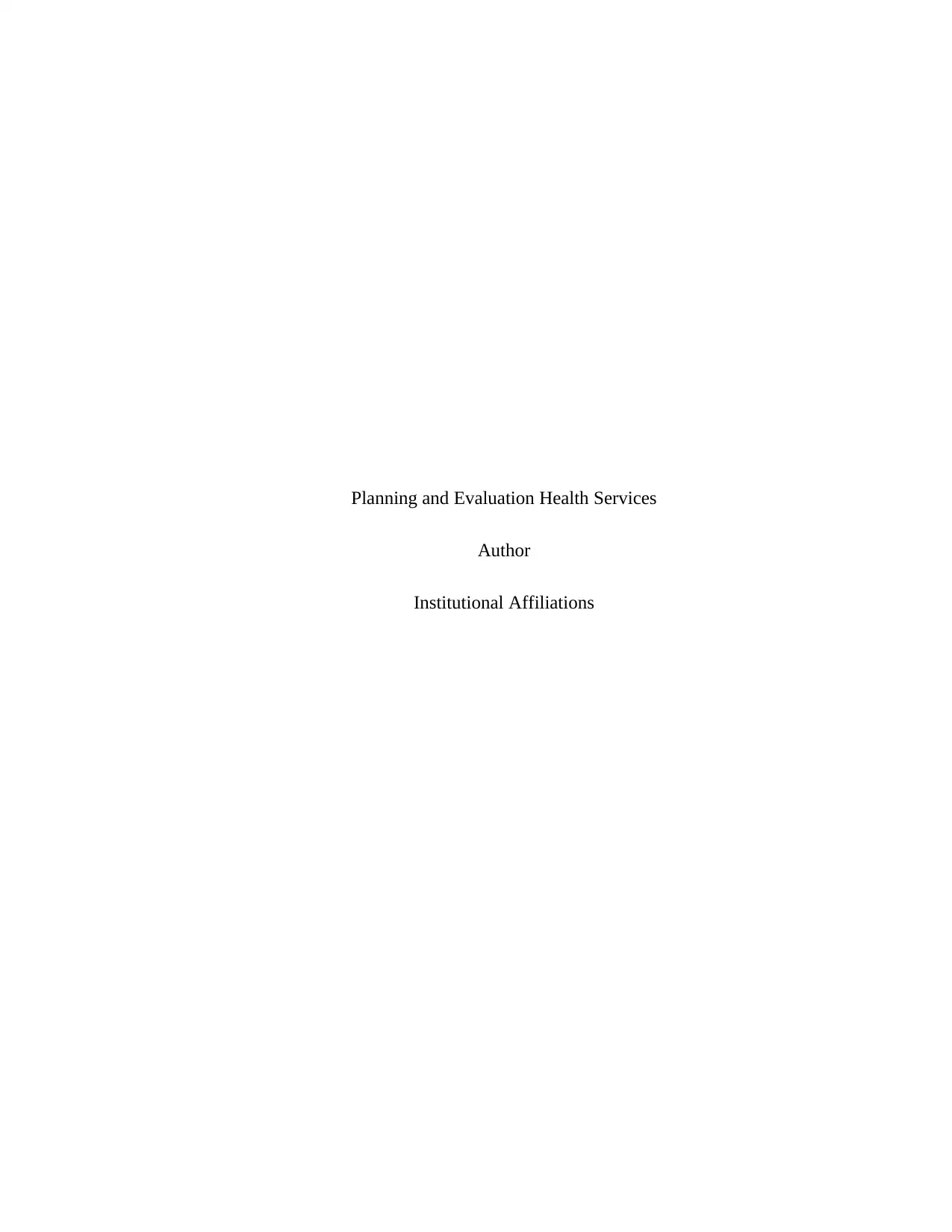
Planning and Evaluation Health Services
Author
Institutional Affiliations
Author
Institutional Affiliations
Paraphrase This Document
Need a fresh take? Get an instant paraphrase of this document with our AI Paraphraser
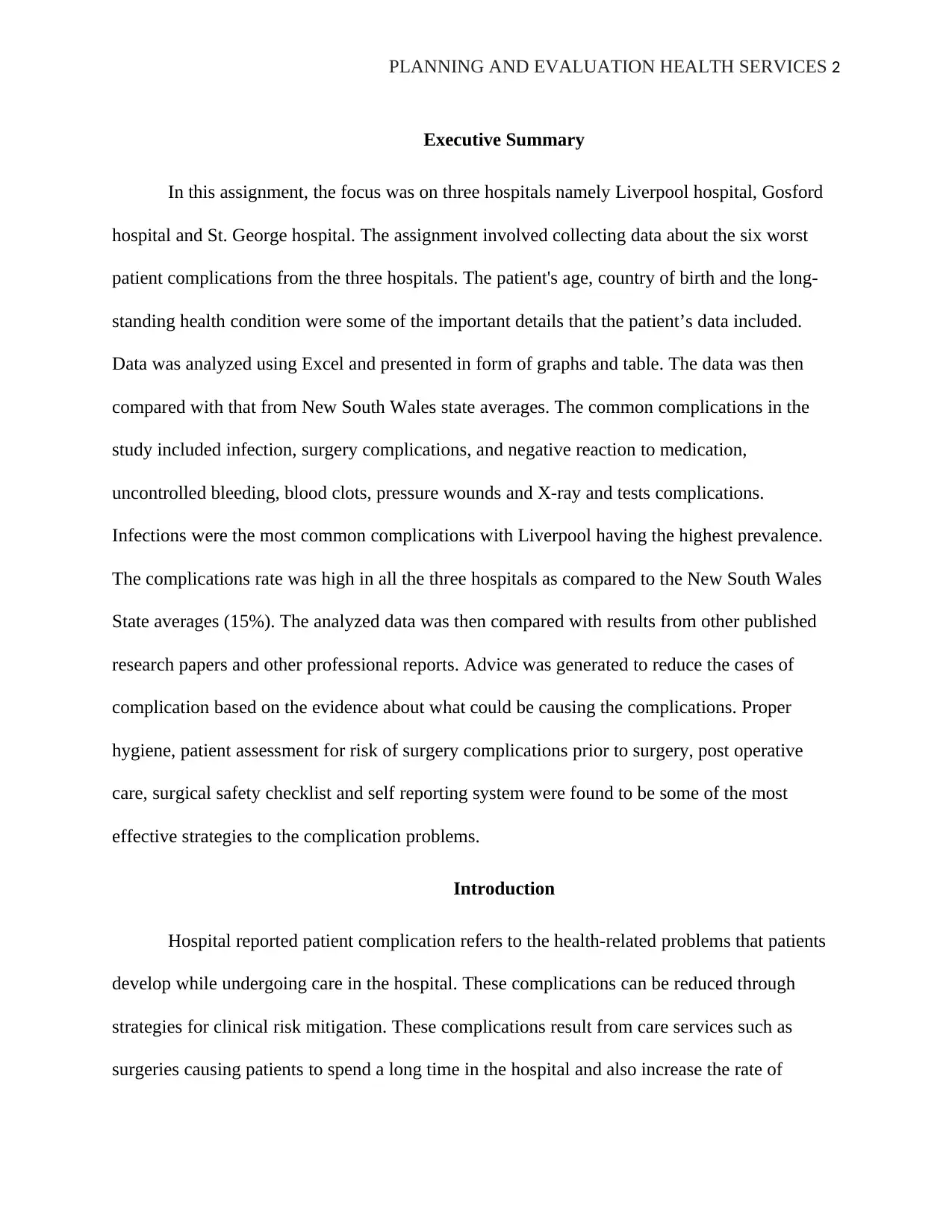
PLANNING AND EVALUATION HEALTH SERVICES 2
Executive Summary
In this assignment, the focus was on three hospitals namely Liverpool hospital, Gosford
hospital and St. George hospital. The assignment involved collecting data about the six worst
patient complications from the three hospitals. The patient's age, country of birth and the long-
standing health condition were some of the important details that the patient’s data included.
Data was analyzed using Excel and presented in form of graphs and table. The data was then
compared with that from New South Wales state averages. The common complications in the
study included infection, surgery complications, and negative reaction to medication,
uncontrolled bleeding, blood clots, pressure wounds and X-ray and tests complications.
Infections were the most common complications with Liverpool having the highest prevalence.
The complications rate was high in all the three hospitals as compared to the New South Wales
State averages (15%). The analyzed data was then compared with results from other published
research papers and other professional reports. Advice was generated to reduce the cases of
complication based on the evidence about what could be causing the complications. Proper
hygiene, patient assessment for risk of surgery complications prior to surgery, post operative
care, surgical safety checklist and self reporting system were found to be some of the most
effective strategies to the complication problems.
Introduction
Hospital reported patient complication refers to the health-related problems that patients
develop while undergoing care in the hospital. These complications can be reduced through
strategies for clinical risk mitigation. These complications result from care services such as
surgeries causing patients to spend a long time in the hospital and also increase the rate of
Executive Summary
In this assignment, the focus was on three hospitals namely Liverpool hospital, Gosford
hospital and St. George hospital. The assignment involved collecting data about the six worst
patient complications from the three hospitals. The patient's age, country of birth and the long-
standing health condition were some of the important details that the patient’s data included.
Data was analyzed using Excel and presented in form of graphs and table. The data was then
compared with that from New South Wales state averages. The common complications in the
study included infection, surgery complications, and negative reaction to medication,
uncontrolled bleeding, blood clots, pressure wounds and X-ray and tests complications.
Infections were the most common complications with Liverpool having the highest prevalence.
The complications rate was high in all the three hospitals as compared to the New South Wales
State averages (15%). The analyzed data was then compared with results from other published
research papers and other professional reports. Advice was generated to reduce the cases of
complication based on the evidence about what could be causing the complications. Proper
hygiene, patient assessment for risk of surgery complications prior to surgery, post operative
care, surgical safety checklist and self reporting system were found to be some of the most
effective strategies to the complication problems.
Introduction
Hospital reported patient complication refers to the health-related problems that patients
develop while undergoing care in the hospital. These complications can be reduced through
strategies for clinical risk mitigation. These complications result from care services such as
surgeries causing patients to spend a long time in the hospital and also increase the rate of
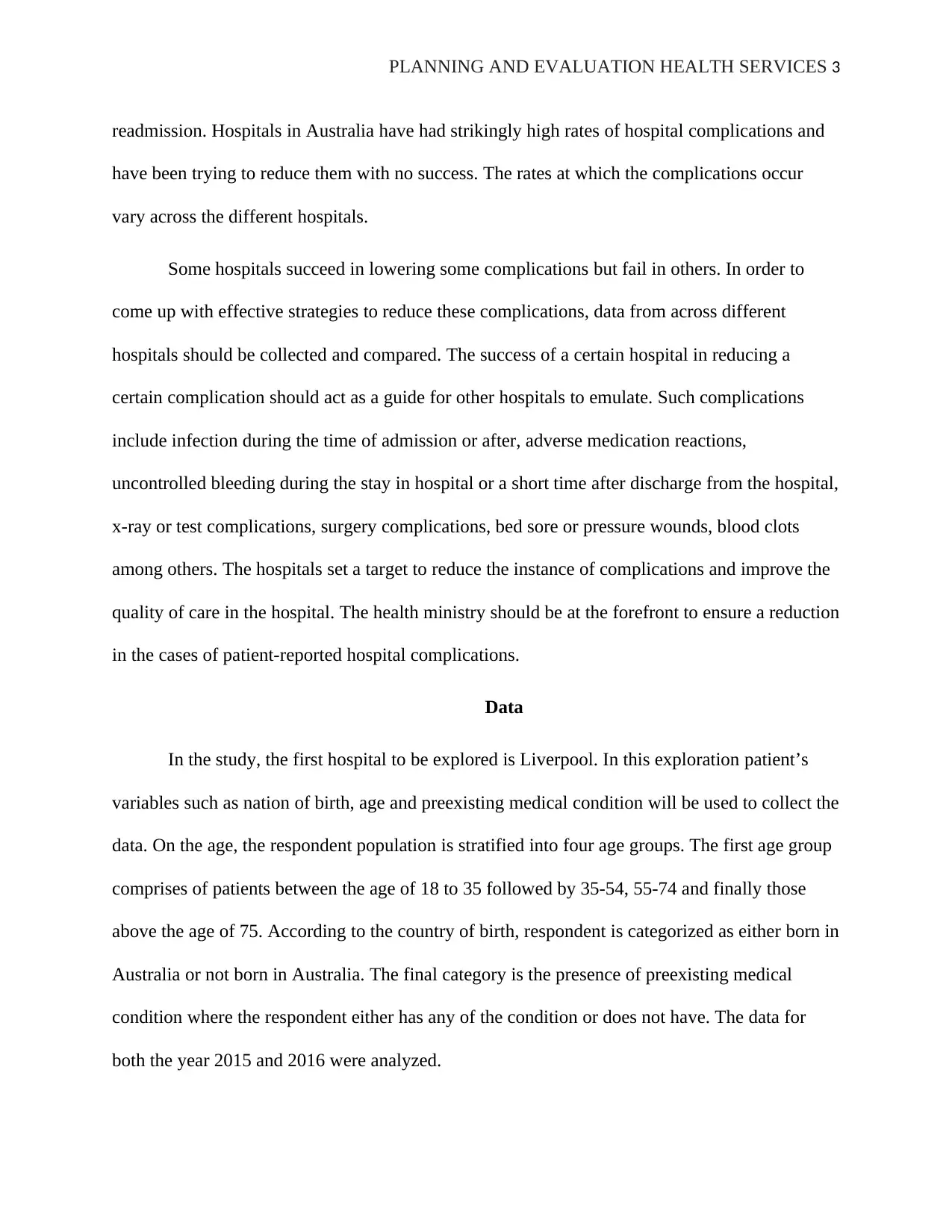
PLANNING AND EVALUATION HEALTH SERVICES 3
readmission. Hospitals in Australia have had strikingly high rates of hospital complications and
have been trying to reduce them with no success. The rates at which the complications occur
vary across the different hospitals.
Some hospitals succeed in lowering some complications but fail in others. In order to
come up with effective strategies to reduce these complications, data from across different
hospitals should be collected and compared. The success of a certain hospital in reducing a
certain complication should act as a guide for other hospitals to emulate. Such complications
include infection during the time of admission or after, adverse medication reactions,
uncontrolled bleeding during the stay in hospital or a short time after discharge from the hospital,
x-ray or test complications, surgery complications, bed sore or pressure wounds, blood clots
among others. The hospitals set a target to reduce the instance of complications and improve the
quality of care in the hospital. The health ministry should be at the forefront to ensure a reduction
in the cases of patient-reported hospital complications.
Data
In the study, the first hospital to be explored is Liverpool. In this exploration patient’s
variables such as nation of birth, age and preexisting medical condition will be used to collect the
data. On the age, the respondent population is stratified into four age groups. The first age group
comprises of patients between the age of 18 to 35 followed by 35-54, 55-74 and finally those
above the age of 75. According to the country of birth, respondent is categorized as either born in
Australia or not born in Australia. The final category is the presence of preexisting medical
condition where the respondent either has any of the condition or does not have. The data for
both the year 2015 and 2016 were analyzed.
readmission. Hospitals in Australia have had strikingly high rates of hospital complications and
have been trying to reduce them with no success. The rates at which the complications occur
vary across the different hospitals.
Some hospitals succeed in lowering some complications but fail in others. In order to
come up with effective strategies to reduce these complications, data from across different
hospitals should be collected and compared. The success of a certain hospital in reducing a
certain complication should act as a guide for other hospitals to emulate. Such complications
include infection during the time of admission or after, adverse medication reactions,
uncontrolled bleeding during the stay in hospital or a short time after discharge from the hospital,
x-ray or test complications, surgery complications, bed sore or pressure wounds, blood clots
among others. The hospitals set a target to reduce the instance of complications and improve the
quality of care in the hospital. The health ministry should be at the forefront to ensure a reduction
in the cases of patient-reported hospital complications.
Data
In the study, the first hospital to be explored is Liverpool. In this exploration patient’s
variables such as nation of birth, age and preexisting medical condition will be used to collect the
data. On the age, the respondent population is stratified into four age groups. The first age group
comprises of patients between the age of 18 to 35 followed by 35-54, 55-74 and finally those
above the age of 75. According to the country of birth, respondent is categorized as either born in
Australia or not born in Australia. The final category is the presence of preexisting medical
condition where the respondent either has any of the condition or does not have. The data for
both the year 2015 and 2016 were analyzed.
You're viewing a preview
Unlock full access by subscribing today!
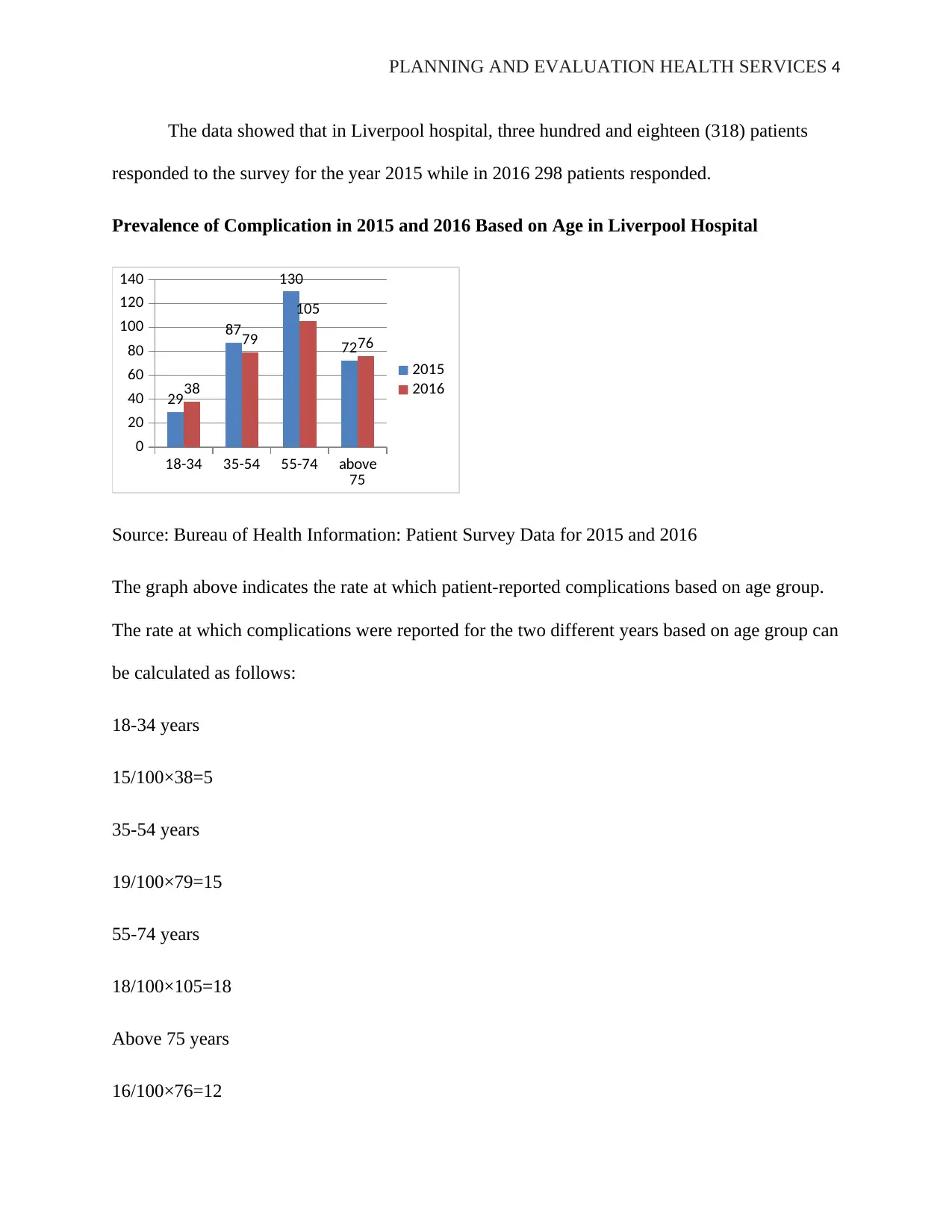
PLANNING AND EVALUATION HEALTH SERVICES 4
The data showed that in Liverpool hospital, three hundred and eighteen (318) patients
responded to the survey for the year 2015 while in 2016 298 patients responded.
Prevalence of Complication in 2015 and 2016 Based on Age in Liverpool Hospital
18-34 35-54 55-74 above
75
0
20
40
60
80
100
120
140
29
87
130
72
38
79
105
76
2015
2016
Source: Bureau of Health Information: Patient Survey Data for 2015 and 2016
The graph above indicates the rate at which patient-reported complications based on age group.
The rate at which complications were reported for the two different years based on age group can
be calculated as follows:
18-34 years
15/100×38=5
35-54 years
19/100×79=15
55-74 years
18/100×105=18
Above 75 years
16/100×76=12
The data showed that in Liverpool hospital, three hundred and eighteen (318) patients
responded to the survey for the year 2015 while in 2016 298 patients responded.
Prevalence of Complication in 2015 and 2016 Based on Age in Liverpool Hospital
18-34 35-54 55-74 above
75
0
20
40
60
80
100
120
140
29
87
130
72
38
79
105
76
2015
2016
Source: Bureau of Health Information: Patient Survey Data for 2015 and 2016
The graph above indicates the rate at which patient-reported complications based on age group.
The rate at which complications were reported for the two different years based on age group can
be calculated as follows:
18-34 years
15/100×38=5
35-54 years
19/100×79=15
55-74 years
18/100×105=18
Above 75 years
16/100×76=12
Paraphrase This Document
Need a fresh take? Get an instant paraphrase of this document with our AI Paraphraser
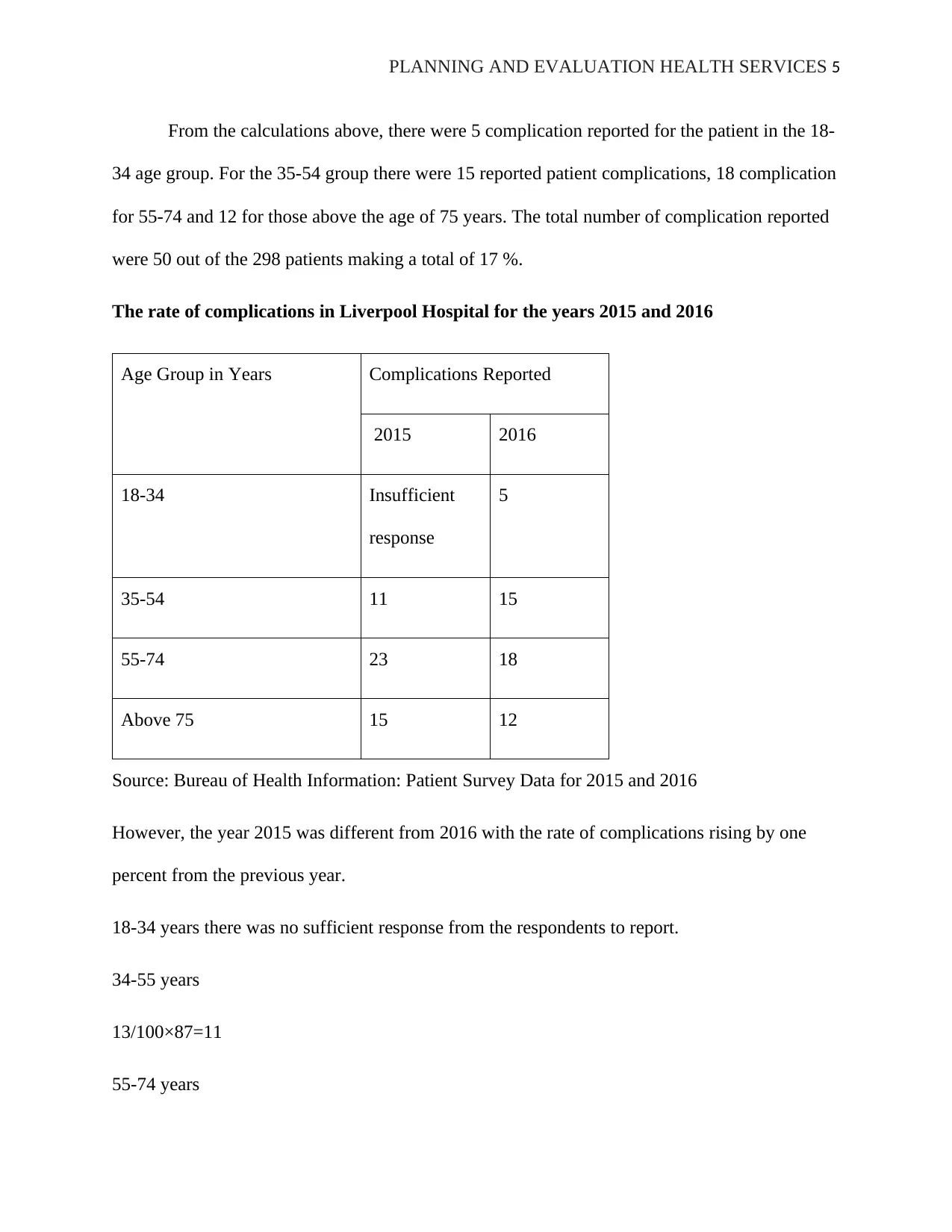
PLANNING AND EVALUATION HEALTH SERVICES 5
From the calculations above, there were 5 complication reported for the patient in the 18-
34 age group. For the 35-54 group there were 15 reported patient complications, 18 complication
for 55-74 and 12 for those above the age of 75 years. The total number of complication reported
were 50 out of the 298 patients making a total of 17 %.
The rate of complications in Liverpool Hospital for the years 2015 and 2016
Age Group in Years Complications Reported
2015 2016
18-34 Insufficient
response
5
35-54 11 15
55-74 23 18
Above 75 15 12
Source: Bureau of Health Information: Patient Survey Data for 2015 and 2016
However, the year 2015 was different from 2016 with the rate of complications rising by one
percent from the previous year.
18-34 years there was no sufficient response from the respondents to report.
34-55 years
13/100×87=11
55-74 years
From the calculations above, there were 5 complication reported for the patient in the 18-
34 age group. For the 35-54 group there were 15 reported patient complications, 18 complication
for 55-74 and 12 for those above the age of 75 years. The total number of complication reported
were 50 out of the 298 patients making a total of 17 %.
The rate of complications in Liverpool Hospital for the years 2015 and 2016
Age Group in Years Complications Reported
2015 2016
18-34 Insufficient
response
5
35-54 11 15
55-74 23 18
Above 75 15 12
Source: Bureau of Health Information: Patient Survey Data for 2015 and 2016
However, the year 2015 was different from 2016 with the rate of complications rising by one
percent from the previous year.
18-34 years there was no sufficient response from the respondents to report.
34-55 years
13/100×87=11
55-74 years

PLANNING AND EVALUATION HEALTH SERVICES 6
18/100×130=23
Above 75 years
22/100×72=15
The data above indicate the complications for each age group for the year 2015. The total
prevalence of complications was 17%.
Data is then stratified according to the presence of a pre-existing chronic medical
condition. In the year 2015, 139 out of the total 318 respondents reported having a long-term
medical condition while 179 did not have any condition. 21 percent out of the
139(21/100×139=29) had complications, while 16 percent of those who had no long-term
condition had complications (16/100×179=28). In 2016 out of 131 patients had long-standing
medical conditions 27 (21/100×131) had complications. Moreover, out of the 167 who reported
having no preexisting long-term medical condition, 23(14/100×167) reported complications.
The rate of complications in patients with long-term medical conditions and those without
any long-term condition in Liverpool Hospital (2015)
Presence of a long-term Medical
condition
Figures Complication
Reported
Condition Present 139 29
No Condition Reported 179 28
Source: Bureau of Health Information: Patient Survey Data for 2015.
18/100×130=23
Above 75 years
22/100×72=15
The data above indicate the complications for each age group for the year 2015. The total
prevalence of complications was 17%.
Data is then stratified according to the presence of a pre-existing chronic medical
condition. In the year 2015, 139 out of the total 318 respondents reported having a long-term
medical condition while 179 did not have any condition. 21 percent out of the
139(21/100×139=29) had complications, while 16 percent of those who had no long-term
condition had complications (16/100×179=28). In 2016 out of 131 patients had long-standing
medical conditions 27 (21/100×131) had complications. Moreover, out of the 167 who reported
having no preexisting long-term medical condition, 23(14/100×167) reported complications.
The rate of complications in patients with long-term medical conditions and those without
any long-term condition in Liverpool Hospital (2015)
Presence of a long-term Medical
condition
Figures Complication
Reported
Condition Present 139 29
No Condition Reported 179 28
Source: Bureau of Health Information: Patient Survey Data for 2015.
You're viewing a preview
Unlock full access by subscribing today!
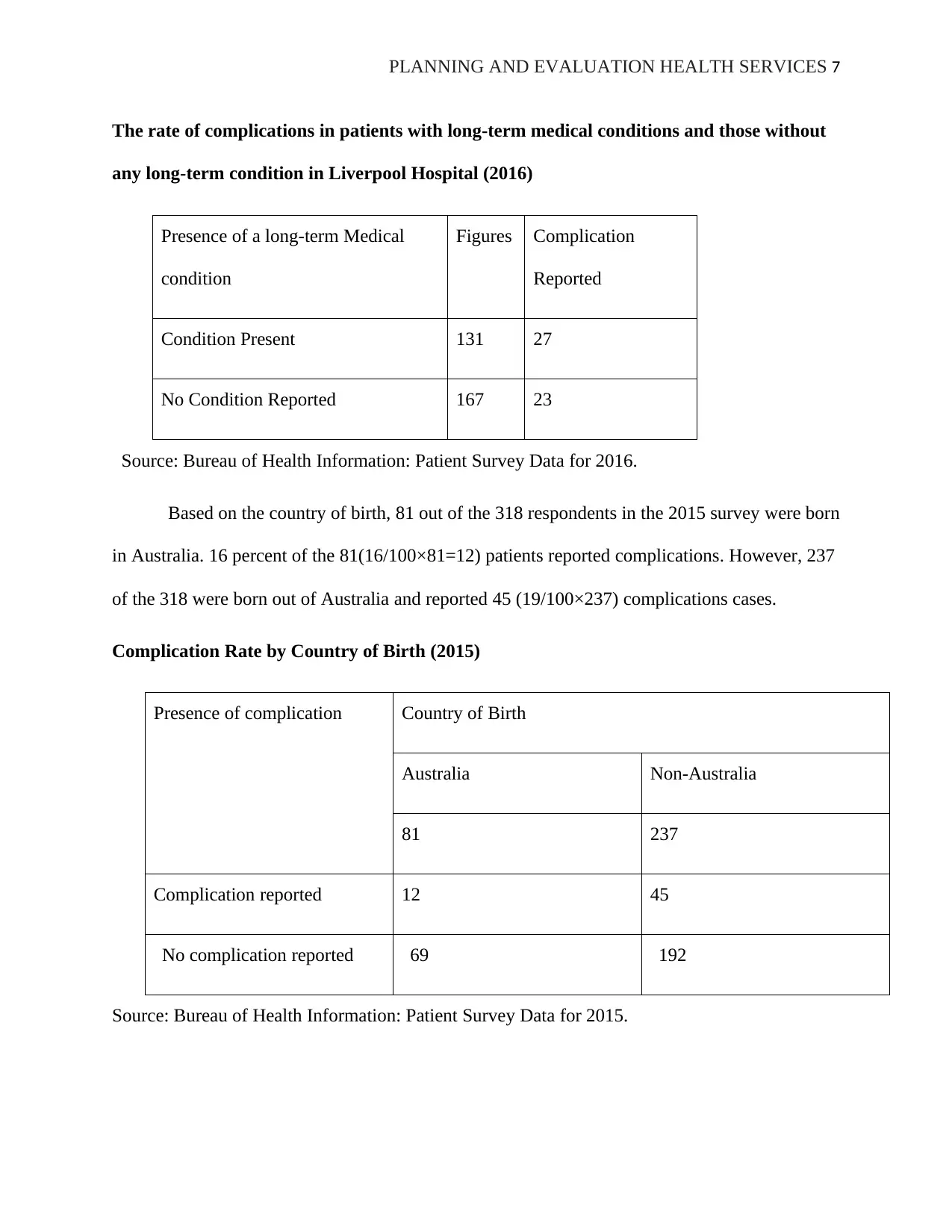
PLANNING AND EVALUATION HEALTH SERVICES 7
The rate of complications in patients with long-term medical conditions and those without
any long-term condition in Liverpool Hospital (2016)
Presence of a long-term Medical
condition
Figures Complication
Reported
Condition Present 131 27
No Condition Reported 167 23
Source: Bureau of Health Information: Patient Survey Data for 2016.
Based on the country of birth, 81 out of the 318 respondents in the 2015 survey were born
in Australia. 16 percent of the 81(16/100×81=12) patients reported complications. However, 237
of the 318 were born out of Australia and reported 45 (19/100×237) complications cases.
Complication Rate by Country of Birth (2015)
Presence of complication Country of Birth
Australia Non-Australia
81 237
Complication reported 12 45
No complication reported 69 192
Source: Bureau of Health Information: Patient Survey Data for 2015.
The rate of complications in patients with long-term medical conditions and those without
any long-term condition in Liverpool Hospital (2016)
Presence of a long-term Medical
condition
Figures Complication
Reported
Condition Present 131 27
No Condition Reported 167 23
Source: Bureau of Health Information: Patient Survey Data for 2016.
Based on the country of birth, 81 out of the 318 respondents in the 2015 survey were born
in Australia. 16 percent of the 81(16/100×81=12) patients reported complications. However, 237
of the 318 were born out of Australia and reported 45 (19/100×237) complications cases.
Complication Rate by Country of Birth (2015)
Presence of complication Country of Birth
Australia Non-Australia
81 237
Complication reported 12 45
No complication reported 69 192
Source: Bureau of Health Information: Patient Survey Data for 2015.
Paraphrase This Document
Need a fresh take? Get an instant paraphrase of this document with our AI Paraphraser
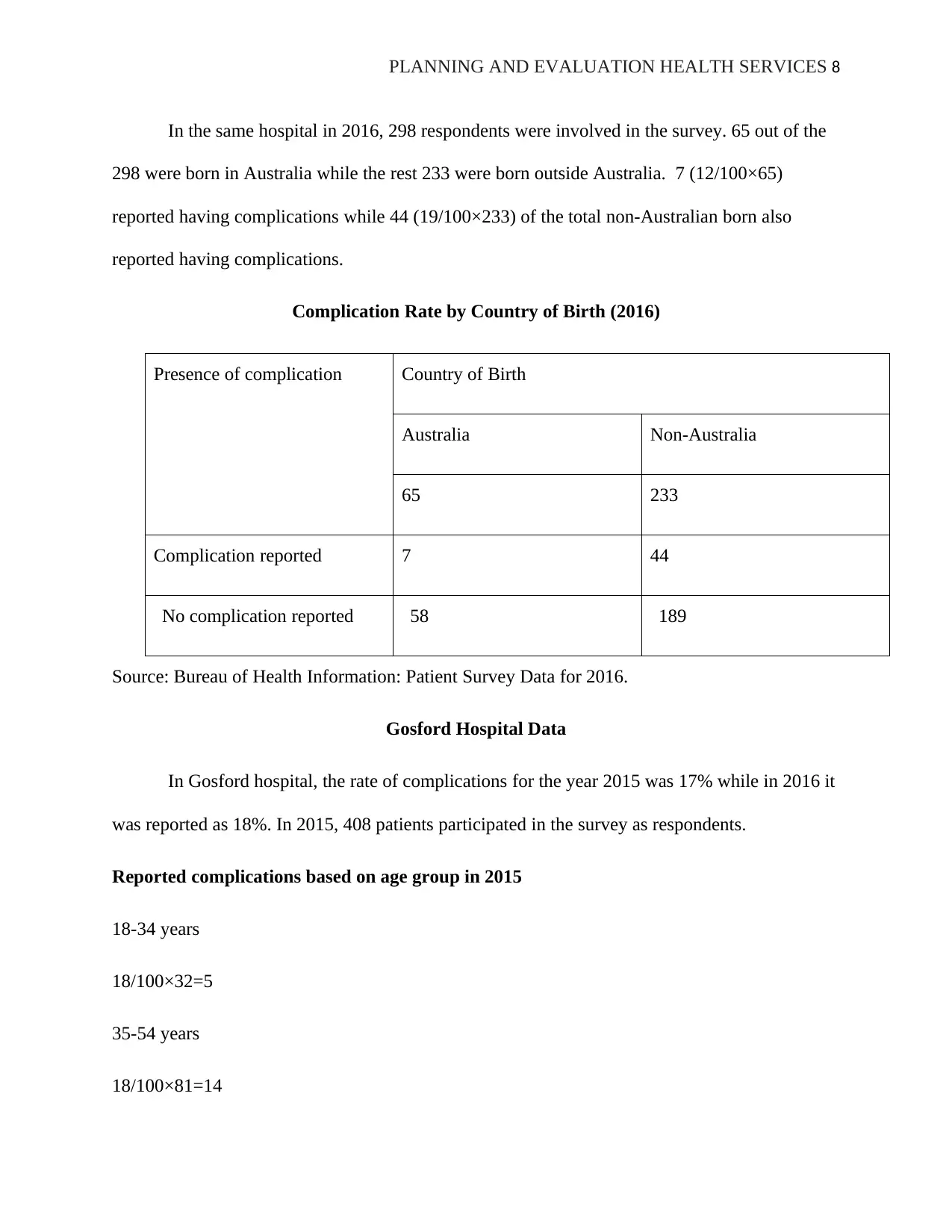
PLANNING AND EVALUATION HEALTH SERVICES 8
In the same hospital in 2016, 298 respondents were involved in the survey. 65 out of the
298 were born in Australia while the rest 233 were born outside Australia. 7 (12/100×65)
reported having complications while 44 (19/100×233) of the total non-Australian born also
reported having complications.
Complication Rate by Country of Birth (2016)
Presence of complication Country of Birth
Australia Non-Australia
65 233
Complication reported 7 44
No complication reported 58 189
Source: Bureau of Health Information: Patient Survey Data for 2016.
Gosford Hospital Data
In Gosford hospital, the rate of complications for the year 2015 was 17% while in 2016 it
was reported as 18%. In 2015, 408 patients participated in the survey as respondents.
Reported complications based on age group in 2015
18-34 years
18/100×32=5
35-54 years
18/100×81=14
In the same hospital in 2016, 298 respondents were involved in the survey. 65 out of the
298 were born in Australia while the rest 233 were born outside Australia. 7 (12/100×65)
reported having complications while 44 (19/100×233) of the total non-Australian born also
reported having complications.
Complication Rate by Country of Birth (2016)
Presence of complication Country of Birth
Australia Non-Australia
65 233
Complication reported 7 44
No complication reported 58 189
Source: Bureau of Health Information: Patient Survey Data for 2016.
Gosford Hospital Data
In Gosford hospital, the rate of complications for the year 2015 was 17% while in 2016 it
was reported as 18%. In 2015, 408 patients participated in the survey as respondents.
Reported complications based on age group in 2015
18-34 years
18/100×32=5
35-54 years
18/100×81=14
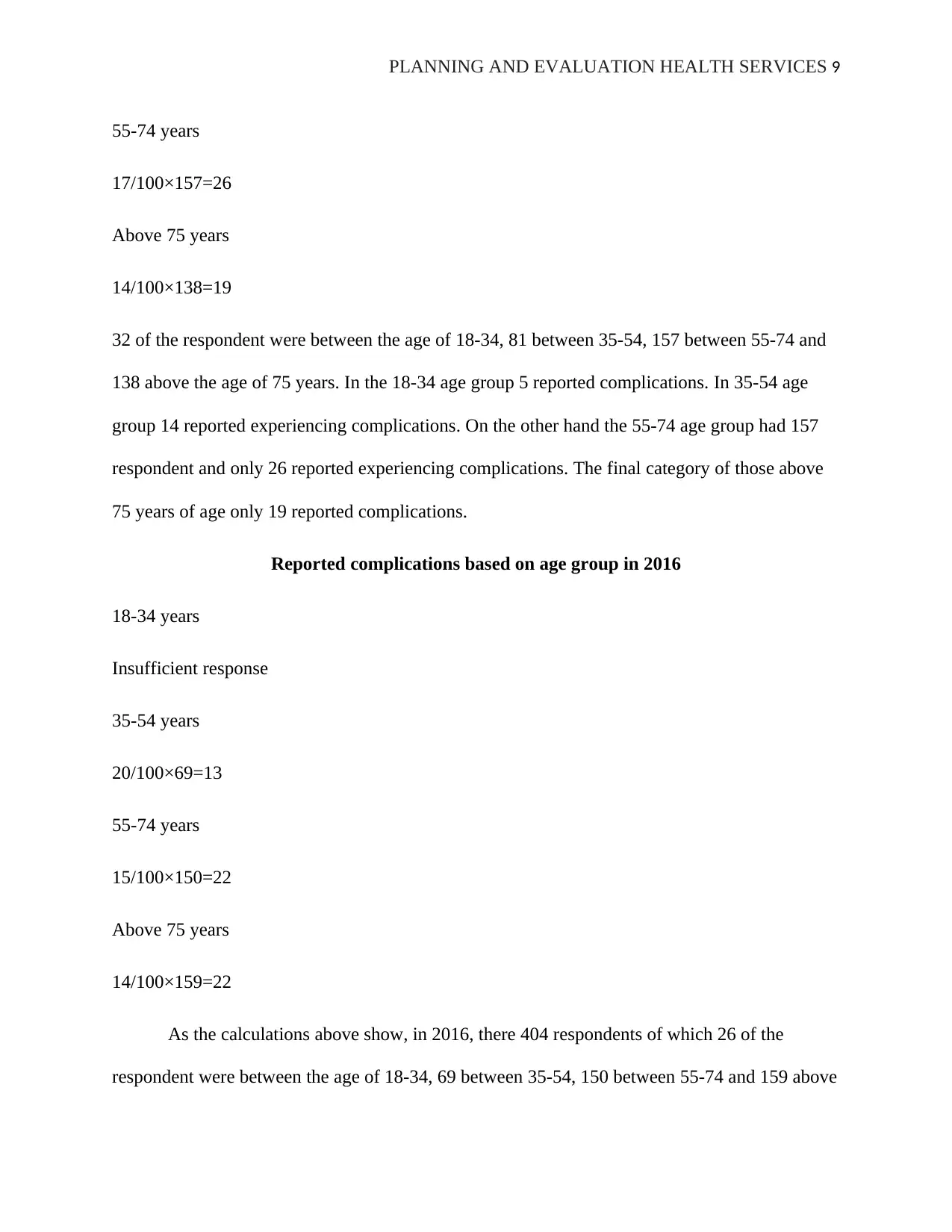
PLANNING AND EVALUATION HEALTH SERVICES 9
55-74 years
17/100×157=26
Above 75 years
14/100×138=19
32 of the respondent were between the age of 18-34, 81 between 35-54, 157 between 55-74 and
138 above the age of 75 years. In the 18-34 age group 5 reported complications. In 35-54 age
group 14 reported experiencing complications. On the other hand the 55-74 age group had 157
respondent and only 26 reported experiencing complications. The final category of those above
75 years of age only 19 reported complications.
Reported complications based on age group in 2016
18-34 years
Insufficient response
35-54 years
20/100×69=13
55-74 years
15/100×150=22
Above 75 years
14/100×159=22
As the calculations above show, in 2016, there 404 respondents of which 26 of the
respondent were between the age of 18-34, 69 between 35-54, 150 between 55-74 and 159 above
55-74 years
17/100×157=26
Above 75 years
14/100×138=19
32 of the respondent were between the age of 18-34, 81 between 35-54, 157 between 55-74 and
138 above the age of 75 years. In the 18-34 age group 5 reported complications. In 35-54 age
group 14 reported experiencing complications. On the other hand the 55-74 age group had 157
respondent and only 26 reported experiencing complications. The final category of those above
75 years of age only 19 reported complications.
Reported complications based on age group in 2016
18-34 years
Insufficient response
35-54 years
20/100×69=13
55-74 years
15/100×150=22
Above 75 years
14/100×159=22
As the calculations above show, in 2016, there 404 respondents of which 26 of the
respondent were between the age of 18-34, 69 between 35-54, 150 between 55-74 and 159 above
You're viewing a preview
Unlock full access by subscribing today!
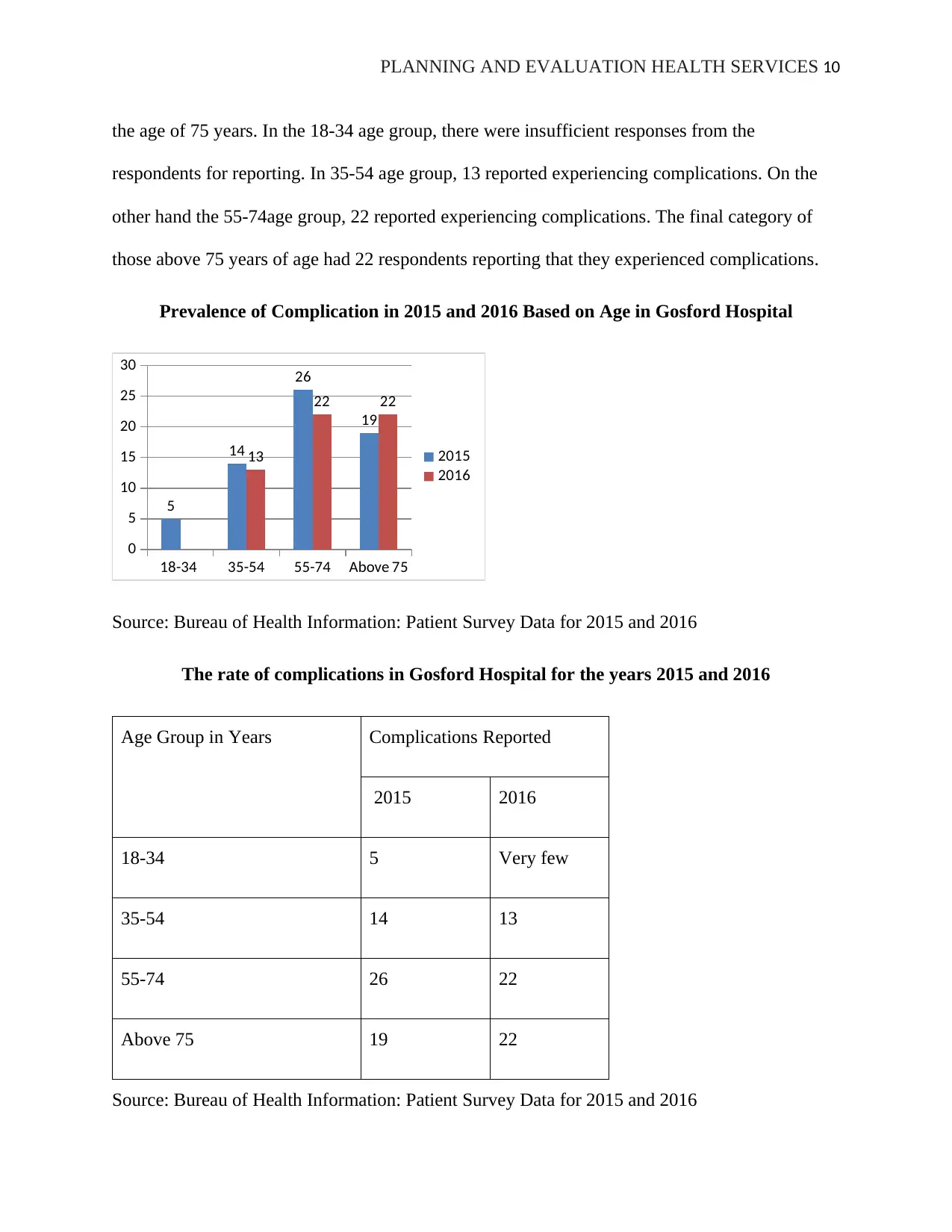
PLANNING AND EVALUATION HEALTH SERVICES 10
the age of 75 years. In the 18-34 age group, there were insufficient responses from the
respondents for reporting. In 35-54 age group, 13 reported experiencing complications. On the
other hand the 55-74age group, 22 reported experiencing complications. The final category of
those above 75 years of age had 22 respondents reporting that they experienced complications.
Prevalence of Complication in 2015 and 2016 Based on Age in Gosford Hospital
18-34 35-54 55-74 Above 75
0
5
10
15
20
25
30
5
14
26
19
13
22 22
2015
2016
Source: Bureau of Health Information: Patient Survey Data for 2015 and 2016
The rate of complications in Gosford Hospital for the years 2015 and 2016
Age Group in Years Complications Reported
2015 2016
18-34 5 Very few
35-54 14 13
55-74 26 22
Above 75 19 22
Source: Bureau of Health Information: Patient Survey Data for 2015 and 2016
the age of 75 years. In the 18-34 age group, there were insufficient responses from the
respondents for reporting. In 35-54 age group, 13 reported experiencing complications. On the
other hand the 55-74age group, 22 reported experiencing complications. The final category of
those above 75 years of age had 22 respondents reporting that they experienced complications.
Prevalence of Complication in 2015 and 2016 Based on Age in Gosford Hospital
18-34 35-54 55-74 Above 75
0
5
10
15
20
25
30
5
14
26
19
13
22 22
2015
2016
Source: Bureau of Health Information: Patient Survey Data for 2015 and 2016
The rate of complications in Gosford Hospital for the years 2015 and 2016
Age Group in Years Complications Reported
2015 2016
18-34 5 Very few
35-54 14 13
55-74 26 22
Above 75 19 22
Source: Bureau of Health Information: Patient Survey Data for 2015 and 2016
Paraphrase This Document
Need a fresh take? Get an instant paraphrase of this document with our AI Paraphraser
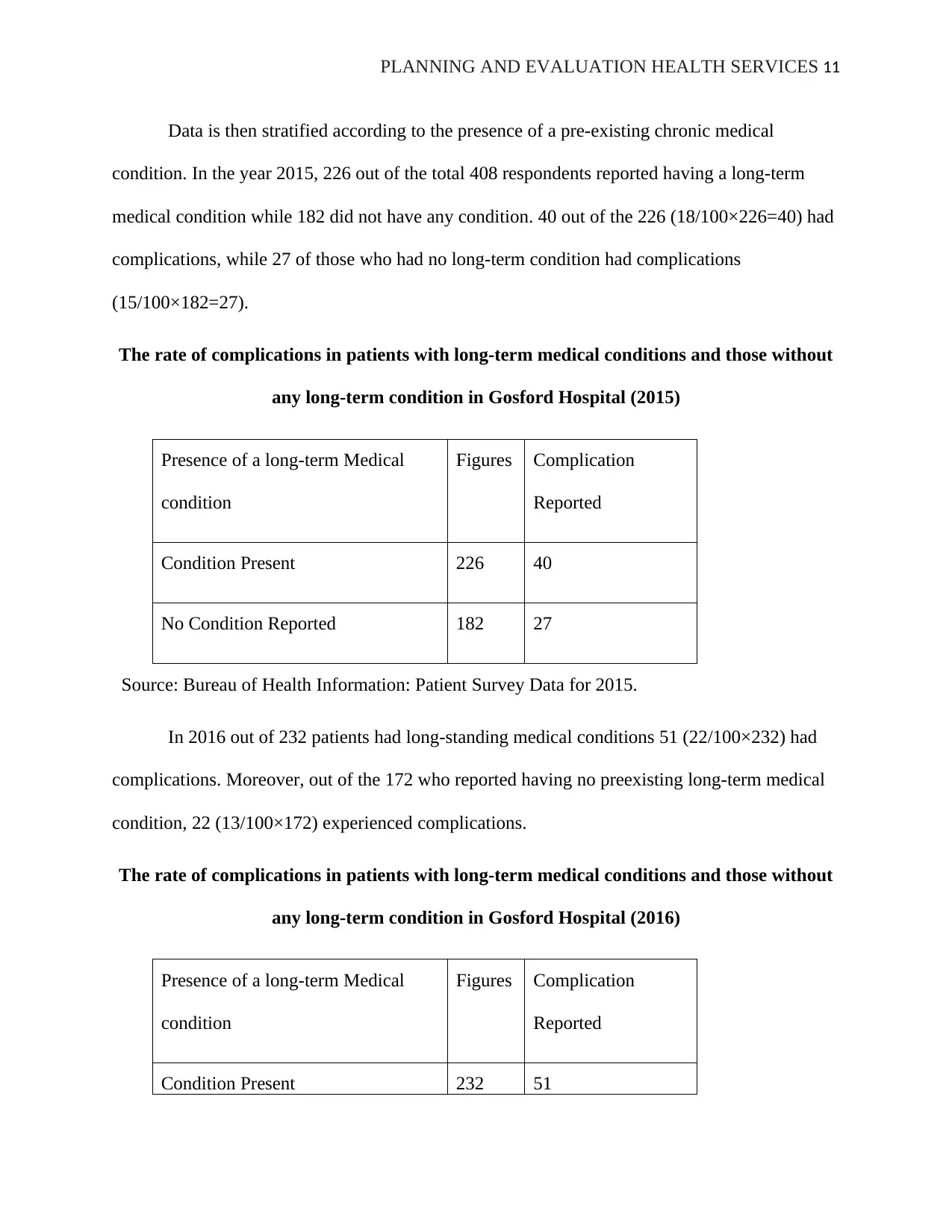
PLANNING AND EVALUATION HEALTH SERVICES 11
Data is then stratified according to the presence of a pre-existing chronic medical
condition. In the year 2015, 226 out of the total 408 respondents reported having a long-term
medical condition while 182 did not have any condition. 40 out of the 226 (18/100×226=40) had
complications, while 27 of those who had no long-term condition had complications
(15/100×182=27).
The rate of complications in patients with long-term medical conditions and those without
any long-term condition in Gosford Hospital (2015)
Presence of a long-term Medical
condition
Figures Complication
Reported
Condition Present 226 40
No Condition Reported 182 27
Source: Bureau of Health Information: Patient Survey Data for 2015.
In 2016 out of 232 patients had long-standing medical conditions 51 (22/100×232) had
complications. Moreover, out of the 172 who reported having no preexisting long-term medical
condition, 22 (13/100×172) experienced complications.
The rate of complications in patients with long-term medical conditions and those without
any long-term condition in Gosford Hospital (2016)
Presence of a long-term Medical
condition
Figures Complication
Reported
Condition Present 232 51
Data is then stratified according to the presence of a pre-existing chronic medical
condition. In the year 2015, 226 out of the total 408 respondents reported having a long-term
medical condition while 182 did not have any condition. 40 out of the 226 (18/100×226=40) had
complications, while 27 of those who had no long-term condition had complications
(15/100×182=27).
The rate of complications in patients with long-term medical conditions and those without
any long-term condition in Gosford Hospital (2015)
Presence of a long-term Medical
condition
Figures Complication
Reported
Condition Present 226 40
No Condition Reported 182 27
Source: Bureau of Health Information: Patient Survey Data for 2015.
In 2016 out of 232 patients had long-standing medical conditions 51 (22/100×232) had
complications. Moreover, out of the 172 who reported having no preexisting long-term medical
condition, 22 (13/100×172) experienced complications.
The rate of complications in patients with long-term medical conditions and those without
any long-term condition in Gosford Hospital (2016)
Presence of a long-term Medical
condition
Figures Complication
Reported
Condition Present 232 51
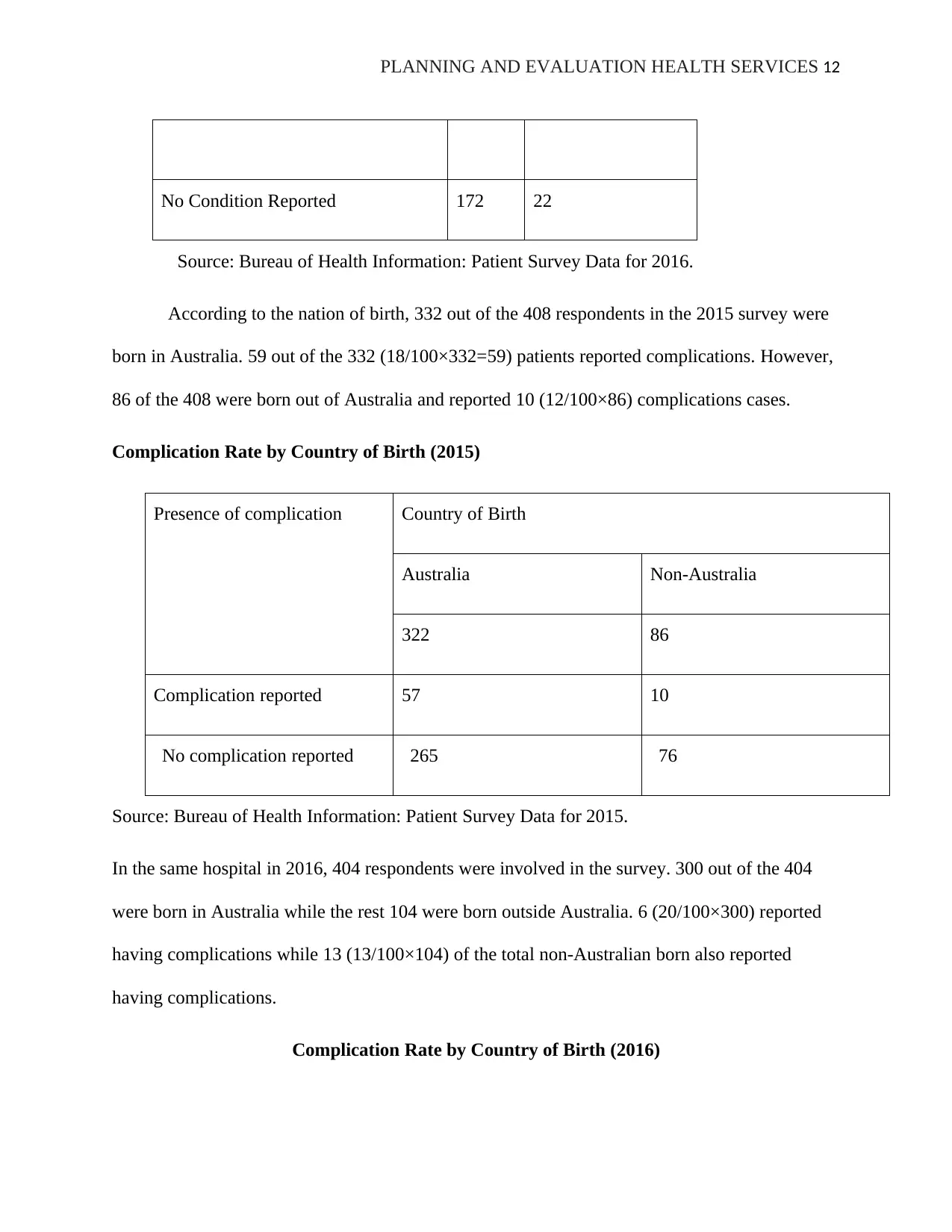
PLANNING AND EVALUATION HEALTH SERVICES 12
No Condition Reported 172 22
Source: Bureau of Health Information: Patient Survey Data for 2016.
According to the nation of birth, 332 out of the 408 respondents in the 2015 survey were
born in Australia. 59 out of the 332 (18/100×332=59) patients reported complications. However,
86 of the 408 were born out of Australia and reported 10 (12/100×86) complications cases.
Complication Rate by Country of Birth (2015)
Presence of complication Country of Birth
Australia Non-Australia
322 86
Complication reported 57 10
No complication reported 265 76
Source: Bureau of Health Information: Patient Survey Data for 2015.
In the same hospital in 2016, 404 respondents were involved in the survey. 300 out of the 404
were born in Australia while the rest 104 were born outside Australia. 6 (20/100×300) reported
having complications while 13 (13/100×104) of the total non-Australian born also reported
having complications.
Complication Rate by Country of Birth (2016)
No Condition Reported 172 22
Source: Bureau of Health Information: Patient Survey Data for 2016.
According to the nation of birth, 332 out of the 408 respondents in the 2015 survey were
born in Australia. 59 out of the 332 (18/100×332=59) patients reported complications. However,
86 of the 408 were born out of Australia and reported 10 (12/100×86) complications cases.
Complication Rate by Country of Birth (2015)
Presence of complication Country of Birth
Australia Non-Australia
322 86
Complication reported 57 10
No complication reported 265 76
Source: Bureau of Health Information: Patient Survey Data for 2015.
In the same hospital in 2016, 404 respondents were involved in the survey. 300 out of the 404
were born in Australia while the rest 104 were born outside Australia. 6 (20/100×300) reported
having complications while 13 (13/100×104) of the total non-Australian born also reported
having complications.
Complication Rate by Country of Birth (2016)
You're viewing a preview
Unlock full access by subscribing today!
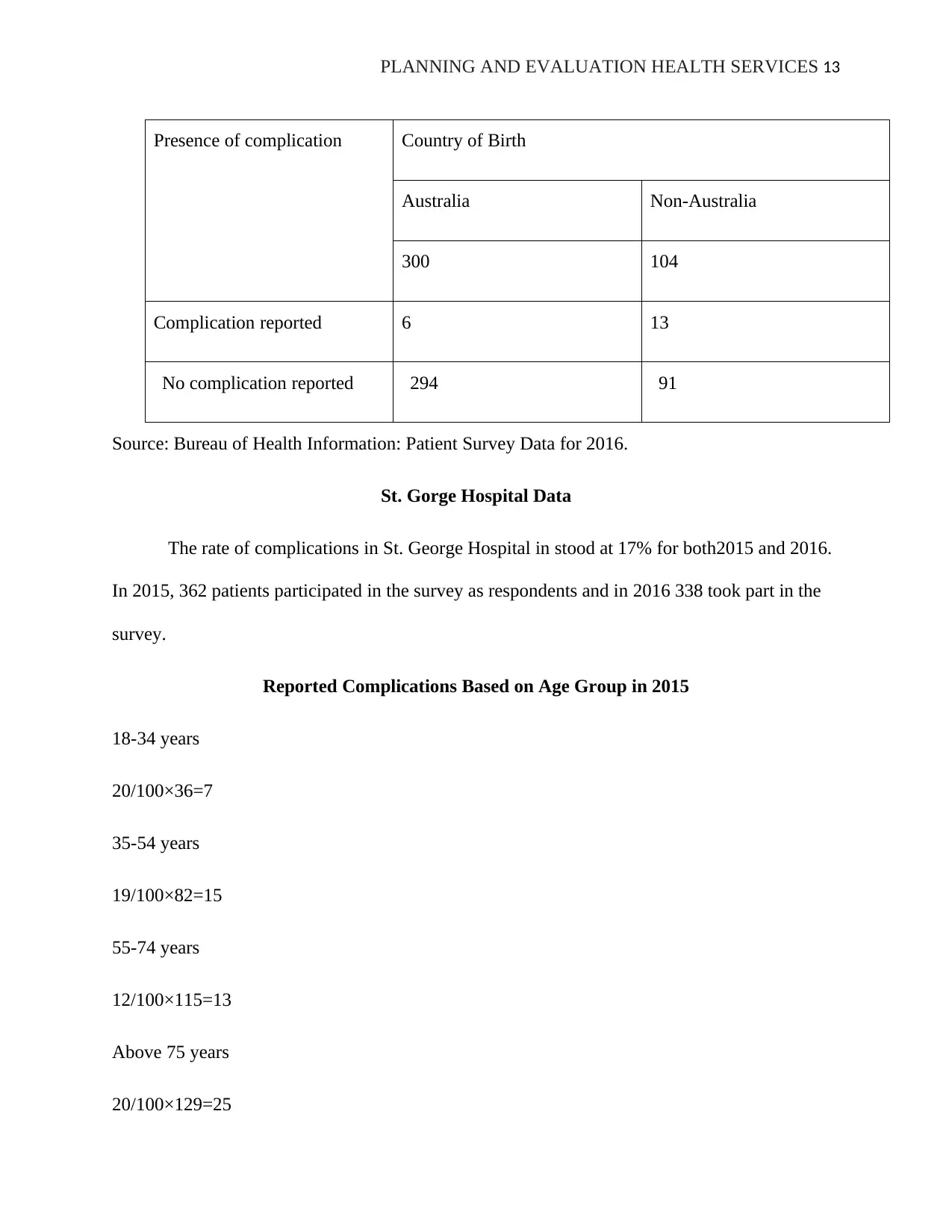
PLANNING AND EVALUATION HEALTH SERVICES 13
Presence of complication Country of Birth
Australia Non-Australia
300 104
Complication reported 6 13
No complication reported 294 91
Source: Bureau of Health Information: Patient Survey Data for 2016.
St. Gorge Hospital Data
The rate of complications in St. George Hospital in stood at 17% for both2015 and 2016.
In 2015, 362 patients participated in the survey as respondents and in 2016 338 took part in the
survey.
Reported Complications Based on Age Group in 2015
18-34 years
20/100×36=7
35-54 years
19/100×82=15
55-74 years
12/100×115=13
Above 75 years
20/100×129=25
Presence of complication Country of Birth
Australia Non-Australia
300 104
Complication reported 6 13
No complication reported 294 91
Source: Bureau of Health Information: Patient Survey Data for 2016.
St. Gorge Hospital Data
The rate of complications in St. George Hospital in stood at 17% for both2015 and 2016.
In 2015, 362 patients participated in the survey as respondents and in 2016 338 took part in the
survey.
Reported Complications Based on Age Group in 2015
18-34 years
20/100×36=7
35-54 years
19/100×82=15
55-74 years
12/100×115=13
Above 75 years
20/100×129=25
Paraphrase This Document
Need a fresh take? Get an instant paraphrase of this document with our AI Paraphraser
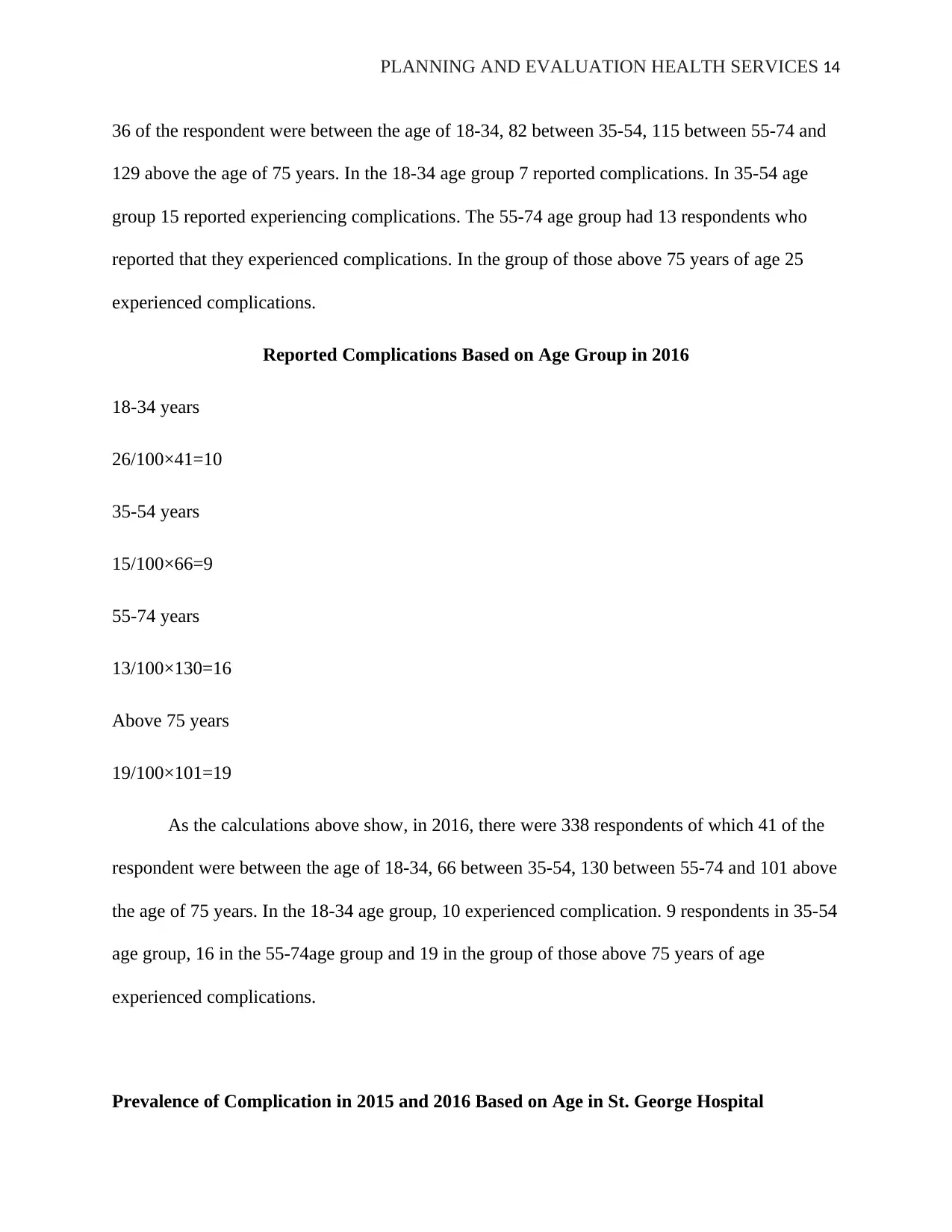
PLANNING AND EVALUATION HEALTH SERVICES 14
36 of the respondent were between the age of 18-34, 82 between 35-54, 115 between 55-74 and
129 above the age of 75 years. In the 18-34 age group 7 reported complications. In 35-54 age
group 15 reported experiencing complications. The 55-74 age group had 13 respondents who
reported that they experienced complications. In the group of those above 75 years of age 25
experienced complications.
Reported Complications Based on Age Group in 2016
18-34 years
26/100×41=10
35-54 years
15/100×66=9
55-74 years
13/100×130=16
Above 75 years
19/100×101=19
As the calculations above show, in 2016, there were 338 respondents of which 41 of the
respondent were between the age of 18-34, 66 between 35-54, 130 between 55-74 and 101 above
the age of 75 years. In the 18-34 age group, 10 experienced complication. 9 respondents in 35-54
age group, 16 in the 55-74age group and 19 in the group of those above 75 years of age
experienced complications.
Prevalence of Complication in 2015 and 2016 Based on Age in St. George Hospital
36 of the respondent were between the age of 18-34, 82 between 35-54, 115 between 55-74 and
129 above the age of 75 years. In the 18-34 age group 7 reported complications. In 35-54 age
group 15 reported experiencing complications. The 55-74 age group had 13 respondents who
reported that they experienced complications. In the group of those above 75 years of age 25
experienced complications.
Reported Complications Based on Age Group in 2016
18-34 years
26/100×41=10
35-54 years
15/100×66=9
55-74 years
13/100×130=16
Above 75 years
19/100×101=19
As the calculations above show, in 2016, there were 338 respondents of which 41 of the
respondent were between the age of 18-34, 66 between 35-54, 130 between 55-74 and 101 above
the age of 75 years. In the 18-34 age group, 10 experienced complication. 9 respondents in 35-54
age group, 16 in the 55-74age group and 19 in the group of those above 75 years of age
experienced complications.
Prevalence of Complication in 2015 and 2016 Based on Age in St. George Hospital
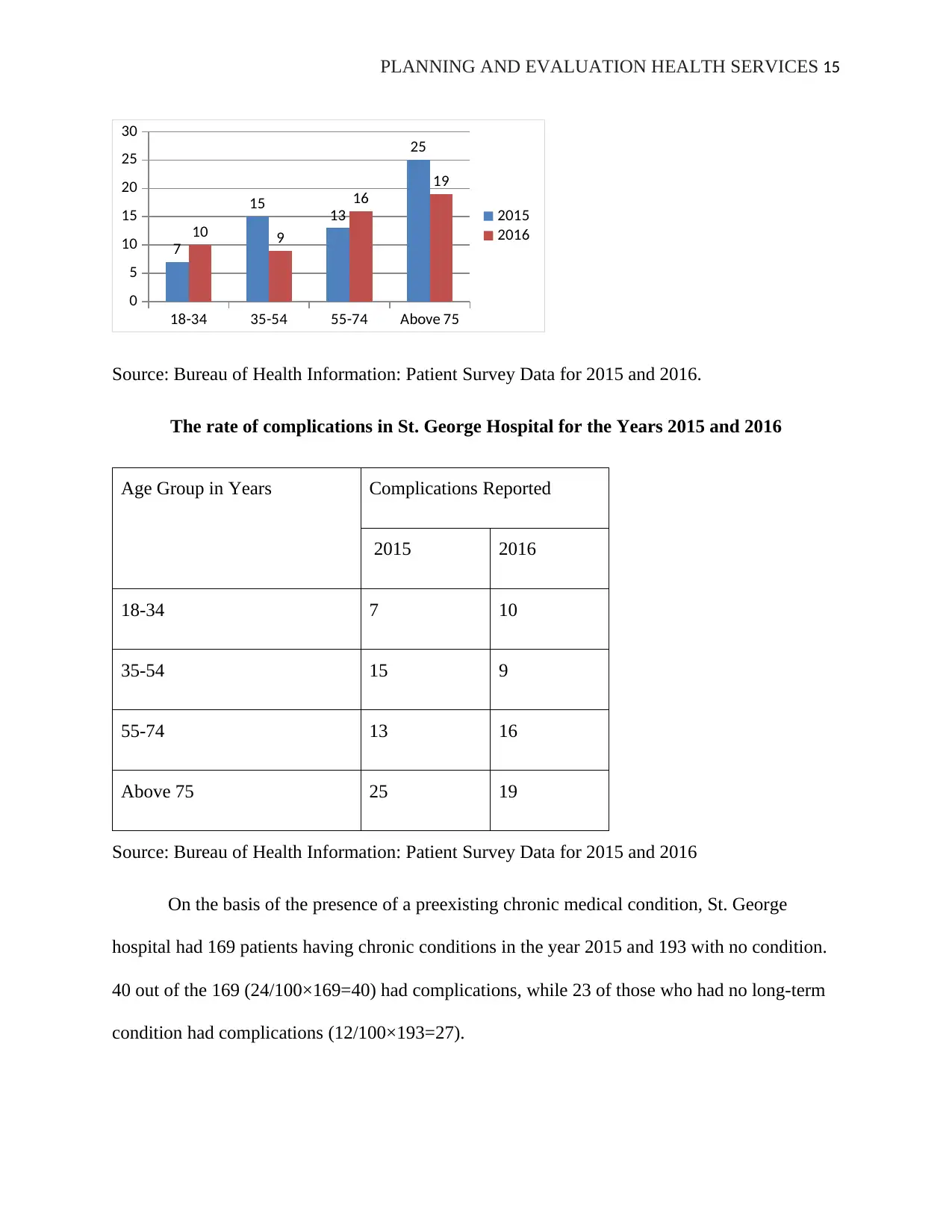
PLANNING AND EVALUATION HEALTH SERVICES 15
18-34 35-54 55-74 Above 75
0
5
10
15
20
25
30
7
15 13
25
10 9
16
19
2015
2016
Source: Bureau of Health Information: Patient Survey Data for 2015 and 2016.
The rate of complications in St. George Hospital for the Years 2015 and 2016
Age Group in Years Complications Reported
2015 2016
18-34 7 10
35-54 15 9
55-74 13 16
Above 75 25 19
Source: Bureau of Health Information: Patient Survey Data for 2015 and 2016
On the basis of the presence of a preexisting chronic medical condition, St. George
hospital had 169 patients having chronic conditions in the year 2015 and 193 with no condition.
40 out of the 169 (24/100×169=40) had complications, while 23 of those who had no long-term
condition had complications (12/100×193=27).
18-34 35-54 55-74 Above 75
0
5
10
15
20
25
30
7
15 13
25
10 9
16
19
2015
2016
Source: Bureau of Health Information: Patient Survey Data for 2015 and 2016.
The rate of complications in St. George Hospital for the Years 2015 and 2016
Age Group in Years Complications Reported
2015 2016
18-34 7 10
35-54 15 9
55-74 13 16
Above 75 25 19
Source: Bureau of Health Information: Patient Survey Data for 2015 and 2016
On the basis of the presence of a preexisting chronic medical condition, St. George
hospital had 169 patients having chronic conditions in the year 2015 and 193 with no condition.
40 out of the 169 (24/100×169=40) had complications, while 23 of those who had no long-term
condition had complications (12/100×193=27).
You're viewing a preview
Unlock full access by subscribing today!

PLANNING AND EVALUATION HEALTH SERVICES 16
The rate of complications in patients with long-term medical conditions and those without
any long-term condition at St. George Hospital (2015)
Presence of long-term Medical
condition
Figures Complication
Reported
Condition Present 169 40
No Condition Reported 193 23
Source: Bureau of Health Information: Patient Survey Data for 2015.
In 2016 out of 151 patients had long-standing medical conditions whereby 31
(21/100×151) out of these had complications. Moreover, out of the 187 who reported having no
preexisting long-term medical condition, 26 (14/100×187) experienced complications.
The rate of Complications in Patients with Long-Term Medical Conditions and those
without any Long-Term Condition in St. George Hospital (2016)
Presence of a long-term Medical
condition
Figures Complication
Reported
Condition Present 151 31
No Condition Reported 187 26
Source: Bureau of Health Information: Patient Survey Data for 2016.
According to the nation of birth, 338 respondents were involved in the survey in 2015.
189 out of the 338 were born in Australia while the rest 173 were born outside Australia. 35
The rate of complications in patients with long-term medical conditions and those without
any long-term condition at St. George Hospital (2015)
Presence of long-term Medical
condition
Figures Complication
Reported
Condition Present 169 40
No Condition Reported 193 23
Source: Bureau of Health Information: Patient Survey Data for 2015.
In 2016 out of 151 patients had long-standing medical conditions whereby 31
(21/100×151) out of these had complications. Moreover, out of the 187 who reported having no
preexisting long-term medical condition, 26 (14/100×187) experienced complications.
The rate of Complications in Patients with Long-Term Medical Conditions and those
without any Long-Term Condition in St. George Hospital (2016)
Presence of a long-term Medical
condition
Figures Complication
Reported
Condition Present 151 31
No Condition Reported 187 26
Source: Bureau of Health Information: Patient Survey Data for 2016.
According to the nation of birth, 338 respondents were involved in the survey in 2015.
189 out of the 338 were born in Australia while the rest 173 were born outside Australia. 35
Paraphrase This Document
Need a fresh take? Get an instant paraphrase of this document with our AI Paraphraser
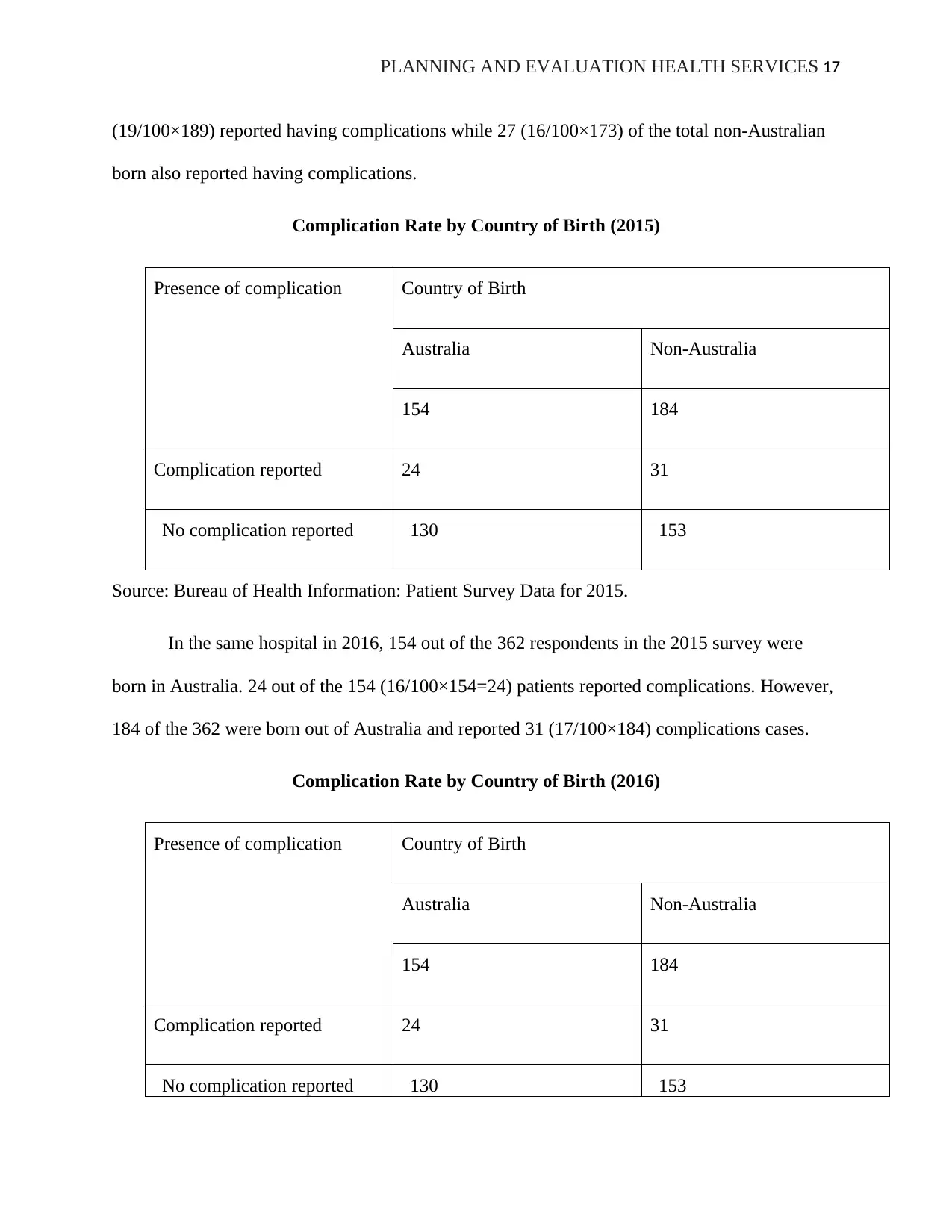
PLANNING AND EVALUATION HEALTH SERVICES 17
(19/100×189) reported having complications while 27 (16/100×173) of the total non-Australian
born also reported having complications.
Complication Rate by Country of Birth (2015)
Presence of complication Country of Birth
Australia Non-Australia
154 184
Complication reported 24 31
No complication reported 130 153
Source: Bureau of Health Information: Patient Survey Data for 2015.
In the same hospital in 2016, 154 out of the 362 respondents in the 2015 survey were
born in Australia. 24 out of the 154 (16/100×154=24) patients reported complications. However,
184 of the 362 were born out of Australia and reported 31 (17/100×184) complications cases.
Complication Rate by Country of Birth (2016)
Presence of complication Country of Birth
Australia Non-Australia
154 184
Complication reported 24 31
No complication reported 130 153
(19/100×189) reported having complications while 27 (16/100×173) of the total non-Australian
born also reported having complications.
Complication Rate by Country of Birth (2015)
Presence of complication Country of Birth
Australia Non-Australia
154 184
Complication reported 24 31
No complication reported 130 153
Source: Bureau of Health Information: Patient Survey Data for 2015.
In the same hospital in 2016, 154 out of the 362 respondents in the 2015 survey were
born in Australia. 24 out of the 154 (16/100×154=24) patients reported complications. However,
184 of the 362 were born out of Australia and reported 31 (17/100×184) complications cases.
Complication Rate by Country of Birth (2016)
Presence of complication Country of Birth
Australia Non-Australia
154 184
Complication reported 24 31
No complication reported 130 153
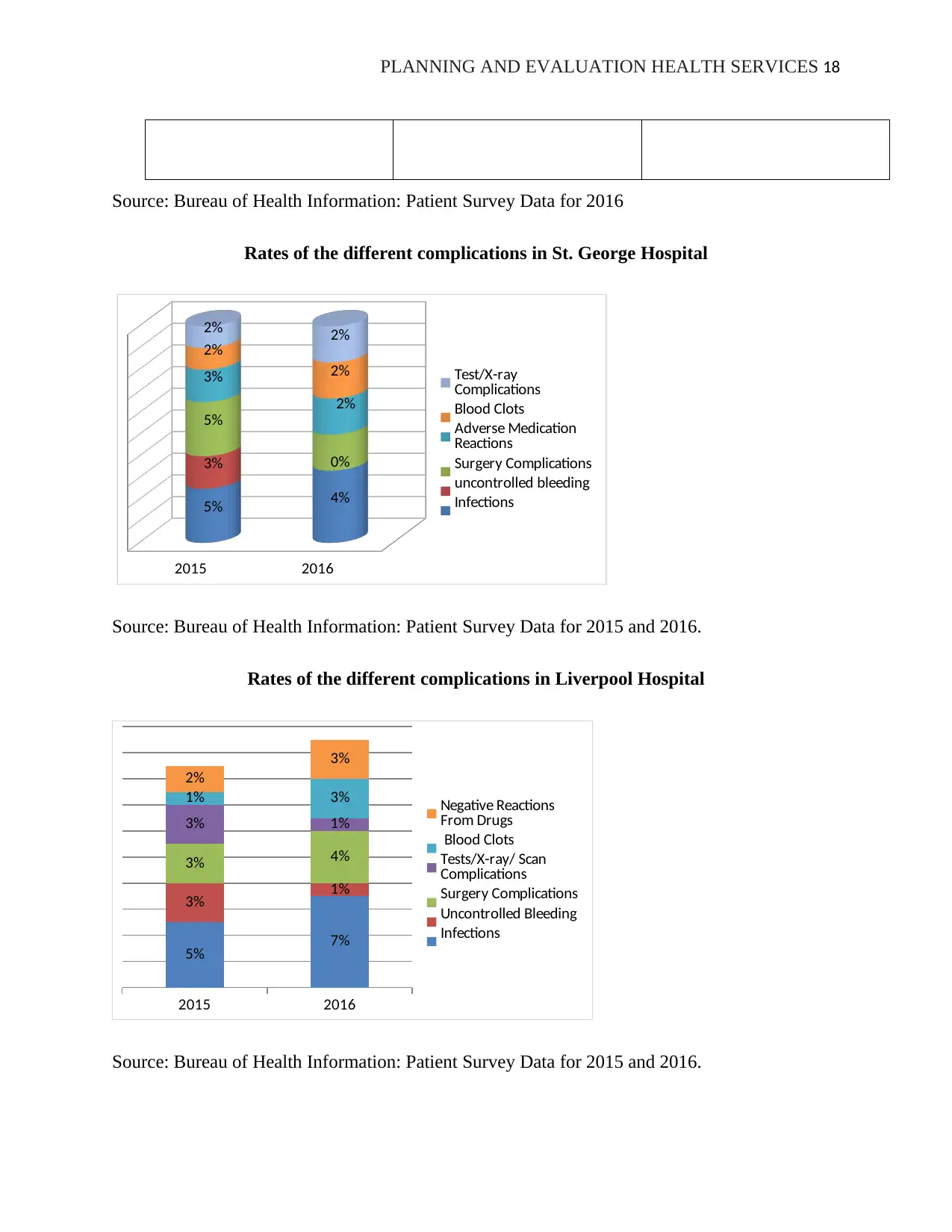
PLANNING AND EVALUATION HEALTH SERVICES 18
Source: Bureau of Health Information: Patient Survey Data for 2016
Rates of the different complications in St. George Hospital
2015 2016
5% 4%
3% 0%
5%
3%
2%
2%
2%
2% 2%
Test/X-ray
Complications
Blood Clots
Adverse Medication
Reactions
Surgery Complications
uncontrolled bleeding
Infections
Source: Bureau of Health Information: Patient Survey Data for 2015 and 2016.
Rates of the different complications in Liverpool Hospital
2015 2016
5% 7%
3% 1%
3% 4%
3% 1%
1% 3%
2%
3%
Negative Reactions
From Drugs
Blood Clots
Tests/X-ray/ Scan
Complications
Surgery Complications
Uncontrolled Bleeding
Infections
Source: Bureau of Health Information: Patient Survey Data for 2015 and 2016.
Source: Bureau of Health Information: Patient Survey Data for 2016
Rates of the different complications in St. George Hospital
2015 2016
5% 4%
3% 0%
5%
3%
2%
2%
2%
2% 2%
Test/X-ray
Complications
Blood Clots
Adverse Medication
Reactions
Surgery Complications
uncontrolled bleeding
Infections
Source: Bureau of Health Information: Patient Survey Data for 2015 and 2016.
Rates of the different complications in Liverpool Hospital
2015 2016
5% 7%
3% 1%
3% 4%
3% 1%
1% 3%
2%
3%
Negative Reactions
From Drugs
Blood Clots
Tests/X-ray/ Scan
Complications
Surgery Complications
Uncontrolled Bleeding
Infections
Source: Bureau of Health Information: Patient Survey Data for 2015 and 2016.
You're viewing a preview
Unlock full access by subscribing today!

PLANNING AND EVALUATION HEALTH SERVICES 19
Rates of the different complications in Gosford Hospital
2015 2016
5% 6%
2% 3%
4% 3%
1%
2%
1% 2%
2% 3%
Negative Medication
Reactions
X-ray/Tests/Scan
Complications
Blood Clots
Surgery
Complications
Uncontrolled Bleeding
Infections
Source: Bureau of Health Information: Patient Survey Data for 2015 and 2016.
Data Analysis
The data obtained from the three hospitals for the two years show a trend in the rate at
which complications occurred. In the Liverpool hospital, the rate of complications was 18% in
the year 2015 and 17% in 2016. On the other hand, in Gosford, the complications rate was 17%
in 2015 and 18% in 2016. St. George hospital had complications rates of 17% in both 2015 and
2016. As compared to the average complication data from the New South Wales the rates of
complications were high for the three hospitals than the state average since the state average rate
of complications was 15% for both 2015 and 2016 (Bureau of Health Information, 2016).
The rate of infectious complications was reported to be high in all the three hospitals for
two years time period. The rates of infections ranged from 4% to 7%. Liverpool had the highest
rate of infectious complications in 2016 (7% with St. George hospital reporting the lowest rate
infections complications in 2016 (4%). As Mitchell, Shaban, MacBeth, Wood, & Russo, (2017)
asserts, Australia has 83,096 cases of hospital-related infections every year (117). According to
Rates of the different complications in Gosford Hospital
2015 2016
5% 6%
2% 3%
4% 3%
1%
2%
1% 2%
2% 3%
Negative Medication
Reactions
X-ray/Tests/Scan
Complications
Blood Clots
Surgery
Complications
Uncontrolled Bleeding
Infections
Source: Bureau of Health Information: Patient Survey Data for 2015 and 2016.
Data Analysis
The data obtained from the three hospitals for the two years show a trend in the rate at
which complications occurred. In the Liverpool hospital, the rate of complications was 18% in
the year 2015 and 17% in 2016. On the other hand, in Gosford, the complications rate was 17%
in 2015 and 18% in 2016. St. George hospital had complications rates of 17% in both 2015 and
2016. As compared to the average complication data from the New South Wales the rates of
complications were high for the three hospitals than the state average since the state average rate
of complications was 15% for both 2015 and 2016 (Bureau of Health Information, 2016).
The rate of infectious complications was reported to be high in all the three hospitals for
two years time period. The rates of infections ranged from 4% to 7%. Liverpool had the highest
rate of infectious complications in 2016 (7% with St. George hospital reporting the lowest rate
infections complications in 2016 (4%). As Mitchell, Shaban, MacBeth, Wood, & Russo, (2017)
asserts, Australia has 83,096 cases of hospital-related infections every year (117). According to
Paraphrase This Document
Need a fresh take? Get an instant paraphrase of this document with our AI Paraphraser
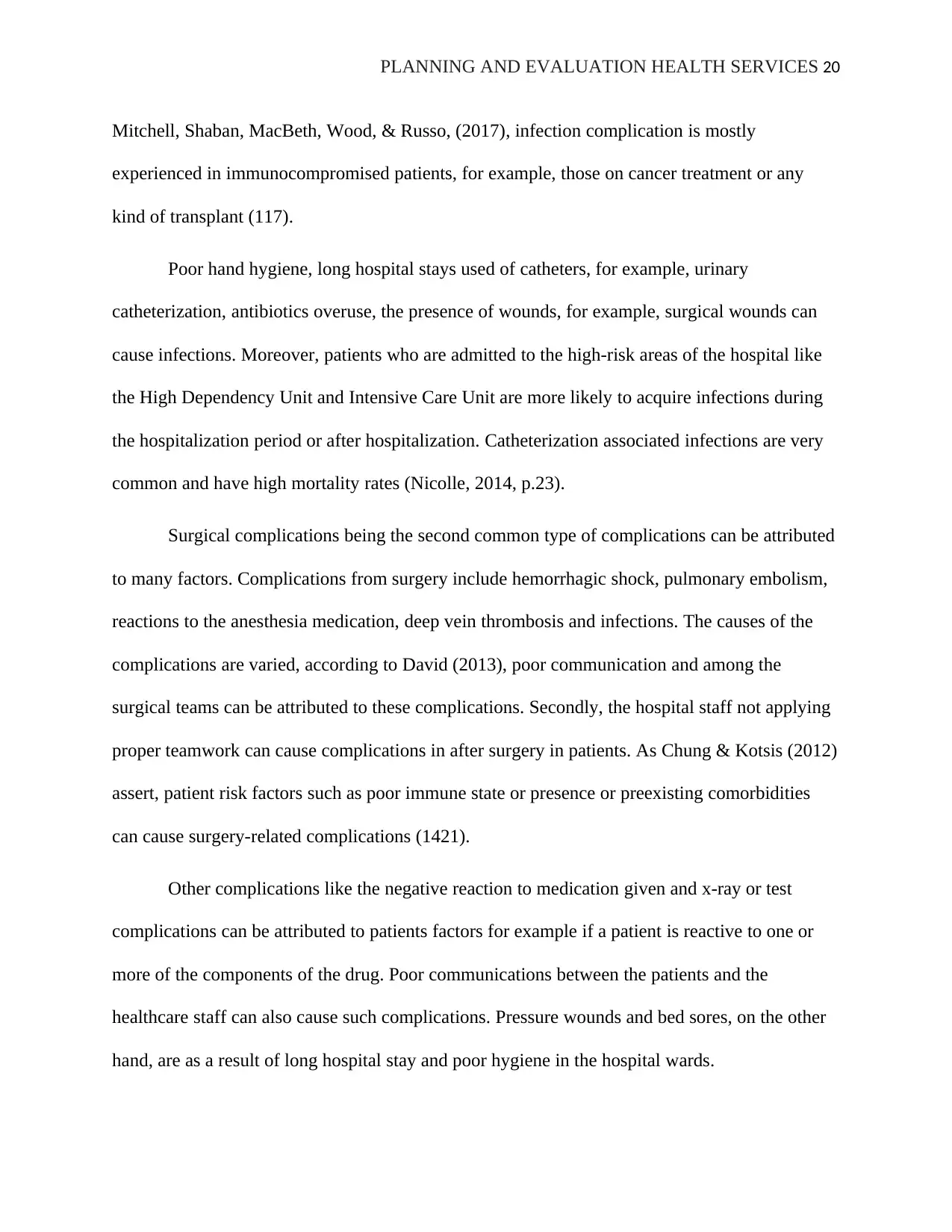
PLANNING AND EVALUATION HEALTH SERVICES 20
Mitchell, Shaban, MacBeth, Wood, & Russo, (2017), infection complication is mostly
experienced in immunocompromised patients, for example, those on cancer treatment or any
kind of transplant (117).
Poor hand hygiene, long hospital stays used of catheters, for example, urinary
catheterization, antibiotics overuse, the presence of wounds, for example, surgical wounds can
cause infections. Moreover, patients who are admitted to the high-risk areas of the hospital like
the High Dependency Unit and Intensive Care Unit are more likely to acquire infections during
the hospitalization period or after hospitalization. Catheterization associated infections are very
common and have high mortality rates (Nicolle, 2014, p.23).
Surgical complications being the second common type of complications can be attributed
to many factors. Complications from surgery include hemorrhagic shock, pulmonary embolism,
reactions to the anesthesia medication, deep vein thrombosis and infections. The causes of the
complications are varied, according to David (2013), poor communication and among the
surgical teams can be attributed to these complications. Secondly, the hospital staff not applying
proper teamwork can cause complications in after surgery in patients. As Chung & Kotsis (2012)
assert, patient risk factors such as poor immune state or presence or preexisting comorbidities
can cause surgery-related complications (1421).
Other complications like the negative reaction to medication given and x-ray or test
complications can be attributed to patients factors for example if a patient is reactive to one or
more of the components of the drug. Poor communications between the patients and the
healthcare staff can also cause such complications. Pressure wounds and bed sores, on the other
hand, are as a result of long hospital stay and poor hygiene in the hospital wards.
Mitchell, Shaban, MacBeth, Wood, & Russo, (2017), infection complication is mostly
experienced in immunocompromised patients, for example, those on cancer treatment or any
kind of transplant (117).
Poor hand hygiene, long hospital stays used of catheters, for example, urinary
catheterization, antibiotics overuse, the presence of wounds, for example, surgical wounds can
cause infections. Moreover, patients who are admitted to the high-risk areas of the hospital like
the High Dependency Unit and Intensive Care Unit are more likely to acquire infections during
the hospitalization period or after hospitalization. Catheterization associated infections are very
common and have high mortality rates (Nicolle, 2014, p.23).
Surgical complications being the second common type of complications can be attributed
to many factors. Complications from surgery include hemorrhagic shock, pulmonary embolism,
reactions to the anesthesia medication, deep vein thrombosis and infections. The causes of the
complications are varied, according to David (2013), poor communication and among the
surgical teams can be attributed to these complications. Secondly, the hospital staff not applying
proper teamwork can cause complications in after surgery in patients. As Chung & Kotsis (2012)
assert, patient risk factors such as poor immune state or presence or preexisting comorbidities
can cause surgery-related complications (1421).
Other complications like the negative reaction to medication given and x-ray or test
complications can be attributed to patients factors for example if a patient is reactive to one or
more of the components of the drug. Poor communications between the patients and the
healthcare staff can also cause such complications. Pressure wounds and bed sores, on the other
hand, are as a result of long hospital stay and poor hygiene in the hospital wards.
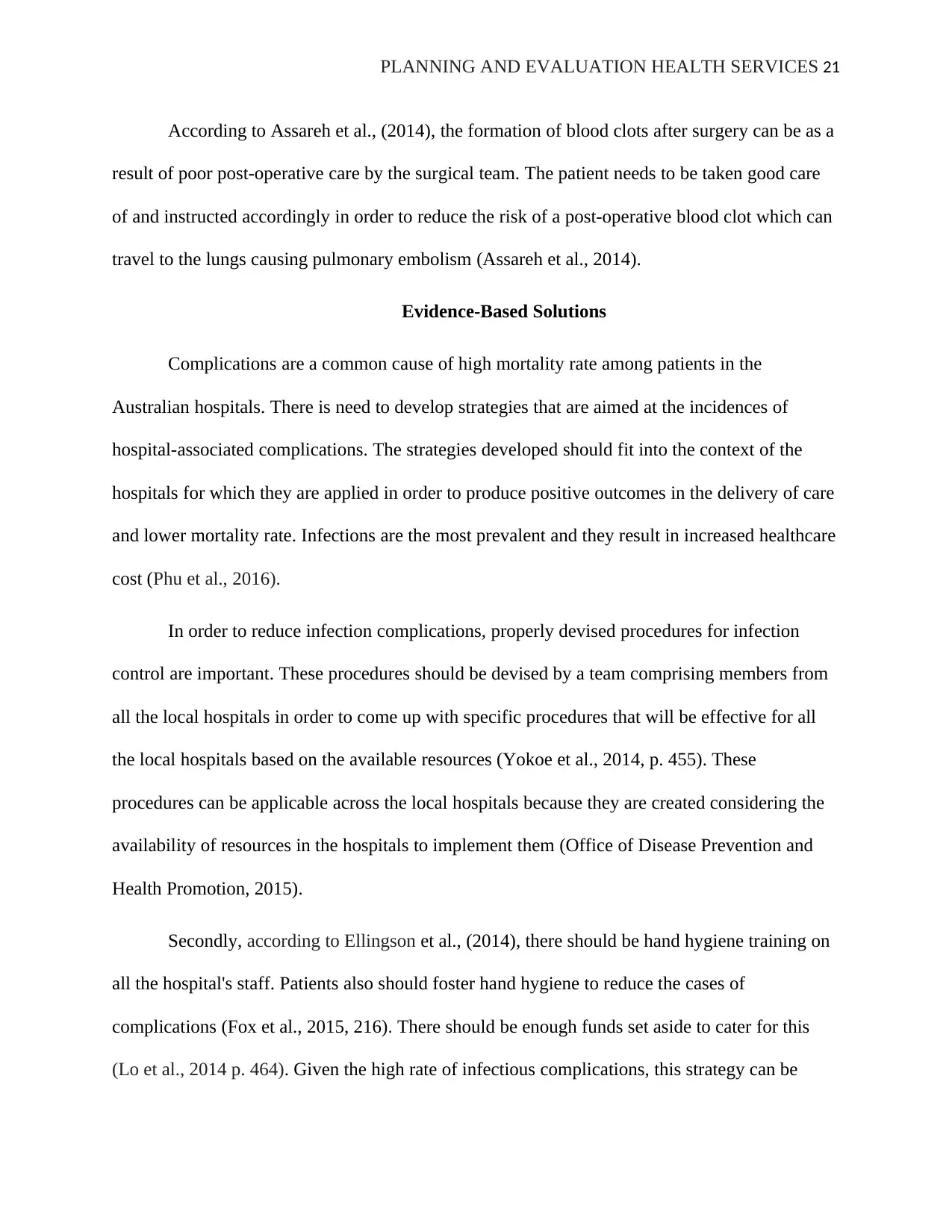
PLANNING AND EVALUATION HEALTH SERVICES 21
According to Assareh et al., (2014), the formation of blood clots after surgery can be as a
result of poor post-operative care by the surgical team. The patient needs to be taken good care
of and instructed accordingly in order to reduce the risk of a post-operative blood clot which can
travel to the lungs causing pulmonary embolism (Assareh et al., 2014).
Evidence-Based Solutions
Complications are a common cause of high mortality rate among patients in the
Australian hospitals. There is need to develop strategies that are aimed at the incidences of
hospital-associated complications. The strategies developed should fit into the context of the
hospitals for which they are applied in order to produce positive outcomes in the delivery of care
and lower mortality rate. Infections are the most prevalent and they result in increased healthcare
cost (Phu et al., 2016).
In order to reduce infection complications, properly devised procedures for infection
control are important. These procedures should be devised by a team comprising members from
all the local hospitals in order to come up with specific procedures that will be effective for all
the local hospitals based on the available resources (Yokoe et al., 2014, p. 455). These
procedures can be applicable across the local hospitals because they are created considering the
availability of resources in the hospitals to implement them (Office of Disease Prevention and
Health Promotion, 2015).
Secondly, according to Ellingson et al., (2014), there should be hand hygiene training on
all the hospital's staff. Patients also should foster hand hygiene to reduce the cases of
complications (Fox et al., 2015, 216). There should be enough funds set aside to cater for this
(Lo et al., 2014 p. 464). Given the high rate of infectious complications, this strategy can be
According to Assareh et al., (2014), the formation of blood clots after surgery can be as a
result of poor post-operative care by the surgical team. The patient needs to be taken good care
of and instructed accordingly in order to reduce the risk of a post-operative blood clot which can
travel to the lungs causing pulmonary embolism (Assareh et al., 2014).
Evidence-Based Solutions
Complications are a common cause of high mortality rate among patients in the
Australian hospitals. There is need to develop strategies that are aimed at the incidences of
hospital-associated complications. The strategies developed should fit into the context of the
hospitals for which they are applied in order to produce positive outcomes in the delivery of care
and lower mortality rate. Infections are the most prevalent and they result in increased healthcare
cost (Phu et al., 2016).
In order to reduce infection complications, properly devised procedures for infection
control are important. These procedures should be devised by a team comprising members from
all the local hospitals in order to come up with specific procedures that will be effective for all
the local hospitals based on the available resources (Yokoe et al., 2014, p. 455). These
procedures can be applicable across the local hospitals because they are created considering the
availability of resources in the hospitals to implement them (Office of Disease Prevention and
Health Promotion, 2015).
Secondly, according to Ellingson et al., (2014), there should be hand hygiene training on
all the hospital's staff. Patients also should foster hand hygiene to reduce the cases of
complications (Fox et al., 2015, 216). There should be enough funds set aside to cater for this
(Lo et al., 2014 p. 464). Given the high rate of infectious complications, this strategy can be
You're viewing a preview
Unlock full access by subscribing today!
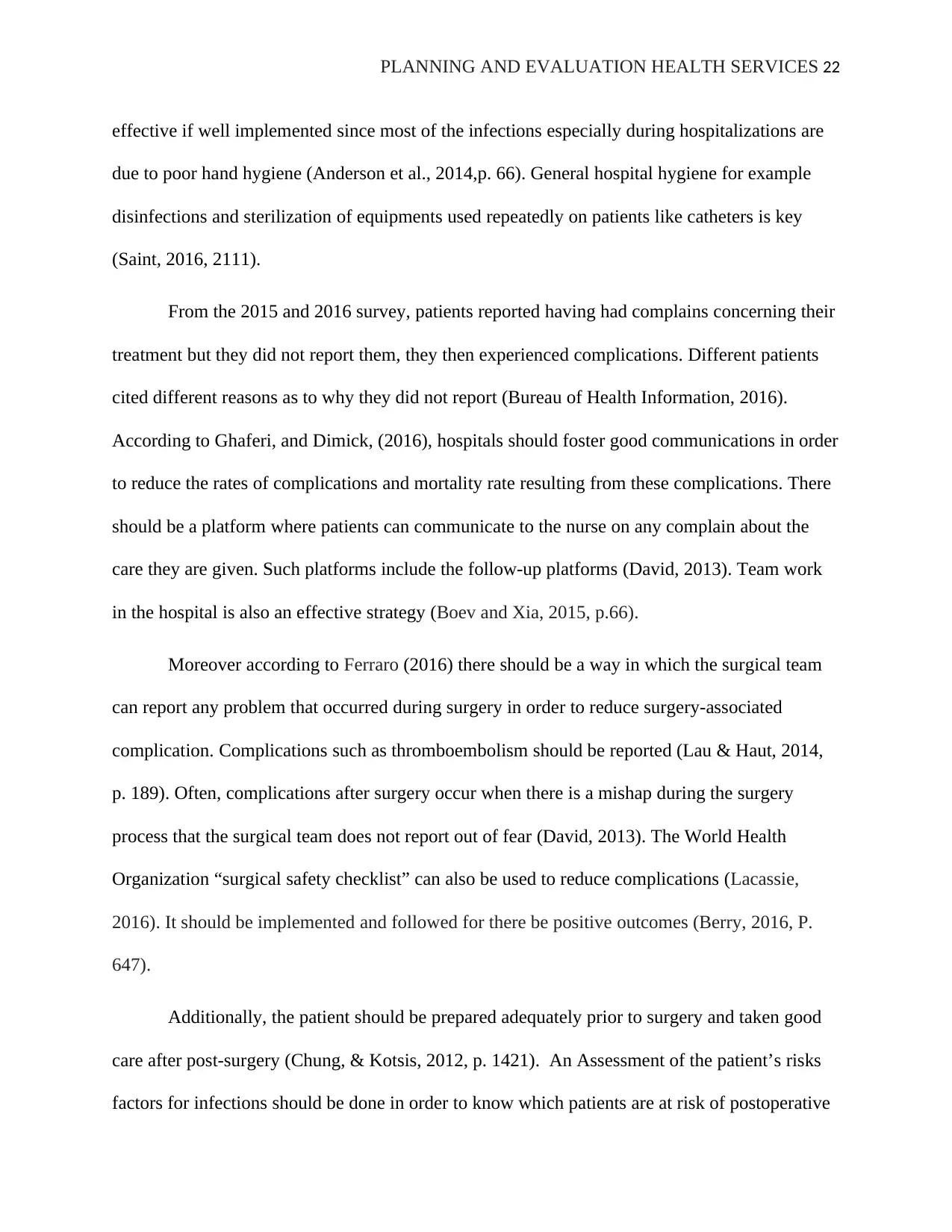
PLANNING AND EVALUATION HEALTH SERVICES 22
effective if well implemented since most of the infections especially during hospitalizations are
due to poor hand hygiene (Anderson et al., 2014,p. 66). General hospital hygiene for example
disinfections and sterilization of equipments used repeatedly on patients like catheters is key
(Saint, 2016, 2111).
From the 2015 and 2016 survey, patients reported having had complains concerning their
treatment but they did not report them, they then experienced complications. Different patients
cited different reasons as to why they did not report (Bureau of Health Information, 2016).
According to Ghaferi, and Dimick, (2016), hospitals should foster good communications in order
to reduce the rates of complications and mortality rate resulting from these complications. There
should be a platform where patients can communicate to the nurse on any complain about the
care they are given. Such platforms include the follow-up platforms (David, 2013). Team work
in the hospital is also an effective strategy (Boev and Xia, 2015, p.66).
Moreover according to Ferraro (2016) there should be a way in which the surgical team
can report any problem that occurred during surgery in order to reduce surgery-associated
complication. Complications such as thromboembolism should be reported (Lau & Haut, 2014,
p. 189). Often, complications after surgery occur when there is a mishap during the surgery
process that the surgical team does not report out of fear (David, 2013). The World Health
Organization “surgical safety checklist” can also be used to reduce complications (Lacassie,
2016). It should be implemented and followed for there be positive outcomes (Berry, 2016, P.
647).
Additionally, the patient should be prepared adequately prior to surgery and taken good
care after post-surgery (Chung, & Kotsis, 2012, p. 1421). An Assessment of the patient’s risks
factors for infections should be done in order to know which patients are at risk of postoperative
effective if well implemented since most of the infections especially during hospitalizations are
due to poor hand hygiene (Anderson et al., 2014,p. 66). General hospital hygiene for example
disinfections and sterilization of equipments used repeatedly on patients like catheters is key
(Saint, 2016, 2111).
From the 2015 and 2016 survey, patients reported having had complains concerning their
treatment but they did not report them, they then experienced complications. Different patients
cited different reasons as to why they did not report (Bureau of Health Information, 2016).
According to Ghaferi, and Dimick, (2016), hospitals should foster good communications in order
to reduce the rates of complications and mortality rate resulting from these complications. There
should be a platform where patients can communicate to the nurse on any complain about the
care they are given. Such platforms include the follow-up platforms (David, 2013). Team work
in the hospital is also an effective strategy (Boev and Xia, 2015, p.66).
Moreover according to Ferraro (2016) there should be a way in which the surgical team
can report any problem that occurred during surgery in order to reduce surgery-associated
complication. Complications such as thromboembolism should be reported (Lau & Haut, 2014,
p. 189). Often, complications after surgery occur when there is a mishap during the surgery
process that the surgical team does not report out of fear (David, 2013). The World Health
Organization “surgical safety checklist” can also be used to reduce complications (Lacassie,
2016). It should be implemented and followed for there be positive outcomes (Berry, 2016, P.
647).
Additionally, the patient should be prepared adequately prior to surgery and taken good
care after post-surgery (Chung, & Kotsis, 2012, p. 1421). An Assessment of the patient’s risks
factors for infections should be done in order to know which patients are at risk of postoperative
Paraphrase This Document
Need a fresh take? Get an instant paraphrase of this document with our AI Paraphraser
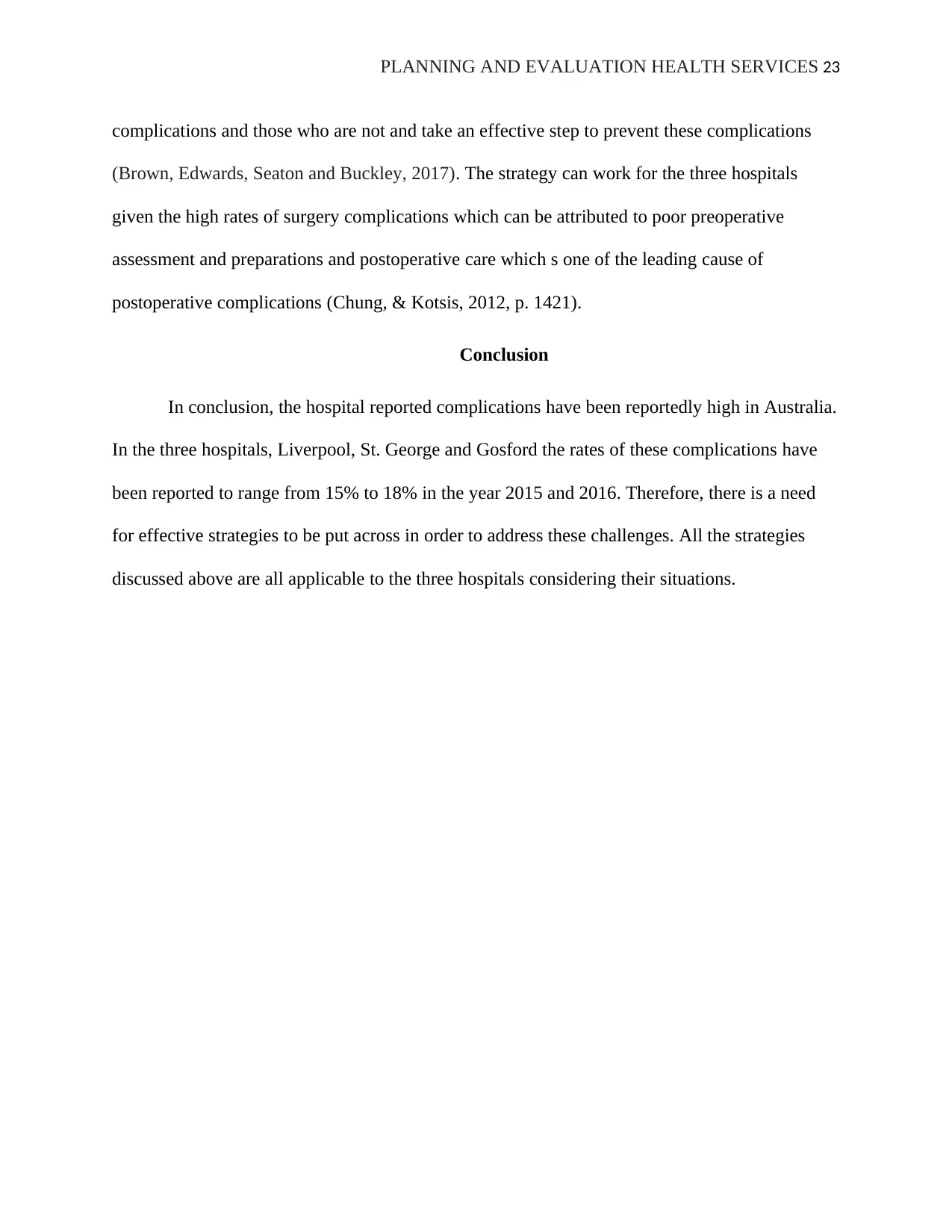
PLANNING AND EVALUATION HEALTH SERVICES 23
complications and those who are not and take an effective step to prevent these complications
(Brown, Edwards, Seaton and Buckley, 2017). The strategy can work for the three hospitals
given the high rates of surgery complications which can be attributed to poor preoperative
assessment and preparations and postoperative care which s one of the leading cause of
postoperative complications (Chung, & Kotsis, 2012, p. 1421).
Conclusion
In conclusion, the hospital reported complications have been reportedly high in Australia.
In the three hospitals, Liverpool, St. George and Gosford the rates of these complications have
been reported to range from 15% to 18% in the year 2015 and 2016. Therefore, there is a need
for effective strategies to be put across in order to address these challenges. All the strategies
discussed above are all applicable to the three hospitals considering their situations.
complications and those who are not and take an effective step to prevent these complications
(Brown, Edwards, Seaton and Buckley, 2017). The strategy can work for the three hospitals
given the high rates of surgery complications which can be attributed to poor preoperative
assessment and preparations and postoperative care which s one of the leading cause of
postoperative complications (Chung, & Kotsis, 2012, p. 1421).
Conclusion
In conclusion, the hospital reported complications have been reportedly high in Australia.
In the three hospitals, Liverpool, St. George and Gosford the rates of these complications have
been reported to range from 15% to 18% in the year 2015 and 2016. Therefore, there is a need
for effective strategies to be put across in order to address these challenges. All the strategies
discussed above are all applicable to the three hospitals considering their situations.

PLANNING AND EVALUATION HEALTH SERVICES 24
References
Anderson, D.J., Podgorny, K., Berríos-Torres, S.I., Bratzler, D.W., Dellinger, E.P., Greene, L.,
Nyquist, A.C., Saiman, L., Yokoe, D.S., Maragakis, L.L. and Kaye, K.S., 2014.
Strategies to prevent surgical site infections in acute care hospitals: 2014
update. Infection Control & Hospital Epidemiology, 35(S2), pp.S66-S88.
Assareh, H., Chen, J., Ou, L., Hollis, S.J., Hillman, K. and Flabouris, A., 2014. Rate of venous
thromboembolism among surgical patients in Australian hospitals: a multicentre
retrospective cohort study. BMJ open, 4(10), p.e005502.
Bureau of Health Information., 2016. Adult admitted patient survey Data for 2015 and 2016.
Retrieved from http://www.bhi.nsw.gov.au/.
Chung, K.C. and Kotsis, S.V., 2012. Complications in surgery: root cause analysis and
preventive measures. Plastic and reconstructive surgery, 129(6), p.1421.
David, A., 2013. Postoperative complications in Australia and New Zealand (the REASON
study). Preoperative Medication. Biomed Central Limited. Retrieved from,
https://dx.doi.org/10.1186%2F2047-0525-2-16
Lau, B. D., & Haut, E. R., 2014. Practices to prevent venous thromboembolism: a brief
review. BMJ Qual Saf, 23(3), 187-195.
Mitchell, B. G., Shaban, R. Z., MacBeth, D., Wood, C. J., & Russo, P. L., 2017. The burden of
healthcare-associated infection in Australian hospitals: A systematic review of the
literature. Infection, Disease & Health, 22(3), 117-128. Retrieved from,
https://doi.org/10.1016/j.idh.2017.07.001\.
References
Anderson, D.J., Podgorny, K., Berríos-Torres, S.I., Bratzler, D.W., Dellinger, E.P., Greene, L.,
Nyquist, A.C., Saiman, L., Yokoe, D.S., Maragakis, L.L. and Kaye, K.S., 2014.
Strategies to prevent surgical site infections in acute care hospitals: 2014
update. Infection Control & Hospital Epidemiology, 35(S2), pp.S66-S88.
Assareh, H., Chen, J., Ou, L., Hollis, S.J., Hillman, K. and Flabouris, A., 2014. Rate of venous
thromboembolism among surgical patients in Australian hospitals: a multicentre
retrospective cohort study. BMJ open, 4(10), p.e005502.
Bureau of Health Information., 2016. Adult admitted patient survey Data for 2015 and 2016.
Retrieved from http://www.bhi.nsw.gov.au/.
Chung, K.C. and Kotsis, S.V., 2012. Complications in surgery: root cause analysis and
preventive measures. Plastic and reconstructive surgery, 129(6), p.1421.
David, A., 2013. Postoperative complications in Australia and New Zealand (the REASON
study). Preoperative Medication. Biomed Central Limited. Retrieved from,
https://dx.doi.org/10.1186%2F2047-0525-2-16
Lau, B. D., & Haut, E. R., 2014. Practices to prevent venous thromboembolism: a brief
review. BMJ Qual Saf, 23(3), 187-195.
Mitchell, B. G., Shaban, R. Z., MacBeth, D., Wood, C. J., & Russo, P. L., 2017. The burden of
healthcare-associated infection in Australian hospitals: A systematic review of the
literature. Infection, Disease & Health, 22(3), 117-128. Retrieved from,
https://doi.org/10.1016/j.idh.2017.07.001\.
You're viewing a preview
Unlock full access by subscribing today!
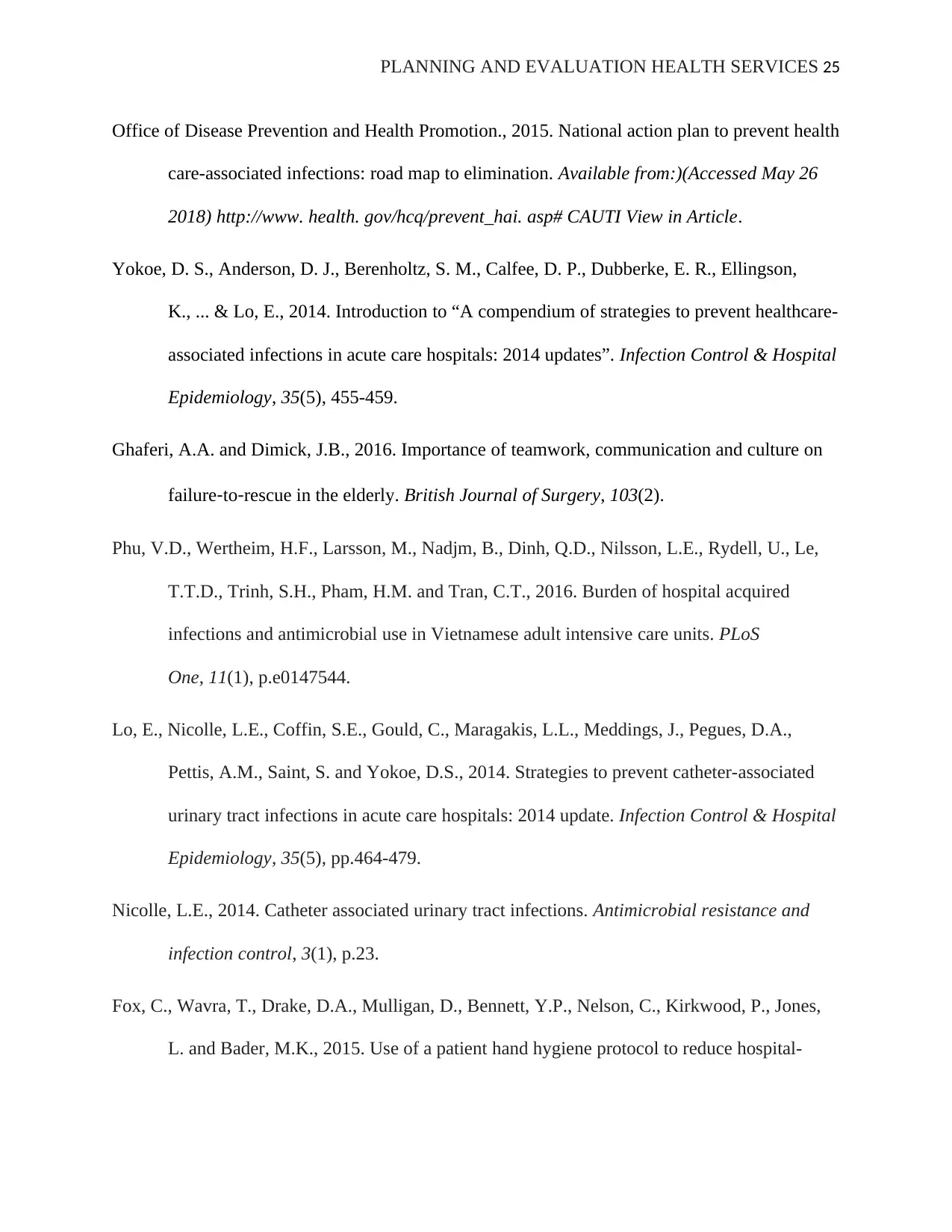
PLANNING AND EVALUATION HEALTH SERVICES 25
Office of Disease Prevention and Health Promotion., 2015. National action plan to prevent health
care-associated infections: road map to elimination. Available from:)(Accessed May 26
2018) http://www. health. gov/hcq/prevent_hai. asp# CAUTI View in Article.
Yokoe, D. S., Anderson, D. J., Berenholtz, S. M., Calfee, D. P., Dubberke, E. R., Ellingson,
K., ... & Lo, E., 2014. Introduction to “A compendium of strategies to prevent healthcare-
associated infections in acute care hospitals: 2014 updates”. Infection Control & Hospital
Epidemiology, 35(5), 455-459.
Ghaferi, A.A. and Dimick, J.B., 2016. Importance of teamwork, communication and culture on
failure‐to‐rescue in the elderly. British Journal of Surgery, 103(2).
Phu, V.D., Wertheim, H.F., Larsson, M., Nadjm, B., Dinh, Q.D., Nilsson, L.E., Rydell, U., Le,
T.T.D., Trinh, S.H., Pham, H.M. and Tran, C.T., 2016. Burden of hospital acquired
infections and antimicrobial use in Vietnamese adult intensive care units. PLoS
One, 11(1), p.e0147544.
Lo, E., Nicolle, L.E., Coffin, S.E., Gould, C., Maragakis, L.L., Meddings, J., Pegues, D.A.,
Pettis, A.M., Saint, S. and Yokoe, D.S., 2014. Strategies to prevent catheter-associated
urinary tract infections in acute care hospitals: 2014 update. Infection Control & Hospital
Epidemiology, 35(5), pp.464-479.
Nicolle, L.E., 2014. Catheter associated urinary tract infections. Antimicrobial resistance and
infection control, 3(1), p.23.
Fox, C., Wavra, T., Drake, D.A., Mulligan, D., Bennett, Y.P., Nelson, C., Kirkwood, P., Jones,
L. and Bader, M.K., 2015. Use of a patient hand hygiene protocol to reduce hospital-
Office of Disease Prevention and Health Promotion., 2015. National action plan to prevent health
care-associated infections: road map to elimination. Available from:)(Accessed May 26
2018) http://www. health. gov/hcq/prevent_hai. asp# CAUTI View in Article.
Yokoe, D. S., Anderson, D. J., Berenholtz, S. M., Calfee, D. P., Dubberke, E. R., Ellingson,
K., ... & Lo, E., 2014. Introduction to “A compendium of strategies to prevent healthcare-
associated infections in acute care hospitals: 2014 updates”. Infection Control & Hospital
Epidemiology, 35(5), 455-459.
Ghaferi, A.A. and Dimick, J.B., 2016. Importance of teamwork, communication and culture on
failure‐to‐rescue in the elderly. British Journal of Surgery, 103(2).
Phu, V.D., Wertheim, H.F., Larsson, M., Nadjm, B., Dinh, Q.D., Nilsson, L.E., Rydell, U., Le,
T.T.D., Trinh, S.H., Pham, H.M. and Tran, C.T., 2016. Burden of hospital acquired
infections and antimicrobial use in Vietnamese adult intensive care units. PLoS
One, 11(1), p.e0147544.
Lo, E., Nicolle, L.E., Coffin, S.E., Gould, C., Maragakis, L.L., Meddings, J., Pegues, D.A.,
Pettis, A.M., Saint, S. and Yokoe, D.S., 2014. Strategies to prevent catheter-associated
urinary tract infections in acute care hospitals: 2014 update. Infection Control & Hospital
Epidemiology, 35(5), pp.464-479.
Nicolle, L.E., 2014. Catheter associated urinary tract infections. Antimicrobial resistance and
infection control, 3(1), p.23.
Fox, C., Wavra, T., Drake, D.A., Mulligan, D., Bennett, Y.P., Nelson, C., Kirkwood, P., Jones,
L. and Bader, M.K., 2015. Use of a patient hand hygiene protocol to reduce hospital-
Paraphrase This Document
Need a fresh take? Get an instant paraphrase of this document with our AI Paraphraser

PLANNING AND EVALUATION HEALTH SERVICES 26
acquired infections and improve nurses’ hand washing. American Journal of Critical
Care, 24(3), pp.216-224.
Boev, C. and Xia, Y., 2015. Nurse-physician collaboration and hospital-acquired infections in
critical care. Critical Care Nurse, 35(2), pp.66-72.
Saint, S., Greene, M.T., Krein, S.L., Rogers, M.A., Ratz, D., Fowler, K.E., Edson, B.S., Watson,
S.R., Meyer-Lucas, B., Masuga, M. and Faulkner, K., 2016. A program to prevent
catheter-associated urinary tract infection in acute care. New England Journal of
Medicine, 374(22), pp.2111-2119.
Lacassie, H.J., Ferdinand, C., Guzmán, S., Camus, L. and Echevarria, G.C., 2016. World Health
Organization (WHO) surgical safety checklist implementation and its impact on
perioperative morbidity and mortality in an academic medical center in
Chile. Medicine, 95(23).
Berry, W., Haynes, A. and Lagoo, J., 2016. The surgical checklist: it cannot work if you do not
use it. JAMA surgery, 151(7), pp.647-647.
Ferraro, E.F., Convercent Inc, 2015. Anonymous reporting system. U.S. Patent 9,135,598.
Ellingson, K., Haas, J.P., Aiello, A.E., Kusek, L., Maragakis, L.L., Olmsted, R.N., Perencevich,
E., Polgreen, P.M., Schweizer, M.L., Trexler, P. and VanAmringe, M., 2014. Strategies to prevent
healthcare-associated infections through hand hygiene. Infection Control & Hospital
Epidemiology, 35(8), pp.937-960.
Fox, C., Wavra, T., Drake, D.A., Mulligan, D., Bennett, Y.P., Nelson, C., Kirkwood, P., Jones, L.
and Bader, M.K., 2015. Use of a patient hand hygiene protocol to reduce hospital-acquired
acquired infections and improve nurses’ hand washing. American Journal of Critical
Care, 24(3), pp.216-224.
Boev, C. and Xia, Y., 2015. Nurse-physician collaboration and hospital-acquired infections in
critical care. Critical Care Nurse, 35(2), pp.66-72.
Saint, S., Greene, M.T., Krein, S.L., Rogers, M.A., Ratz, D., Fowler, K.E., Edson, B.S., Watson,
S.R., Meyer-Lucas, B., Masuga, M. and Faulkner, K., 2016. A program to prevent
catheter-associated urinary tract infection in acute care. New England Journal of
Medicine, 374(22), pp.2111-2119.
Lacassie, H.J., Ferdinand, C., Guzmán, S., Camus, L. and Echevarria, G.C., 2016. World Health
Organization (WHO) surgical safety checklist implementation and its impact on
perioperative morbidity and mortality in an academic medical center in
Chile. Medicine, 95(23).
Berry, W., Haynes, A. and Lagoo, J., 2016. The surgical checklist: it cannot work if you do not
use it. JAMA surgery, 151(7), pp.647-647.
Ferraro, E.F., Convercent Inc, 2015. Anonymous reporting system. U.S. Patent 9,135,598.
Ellingson, K., Haas, J.P., Aiello, A.E., Kusek, L., Maragakis, L.L., Olmsted, R.N., Perencevich,
E., Polgreen, P.M., Schweizer, M.L., Trexler, P. and VanAmringe, M., 2014. Strategies to prevent
healthcare-associated infections through hand hygiene. Infection Control & Hospital
Epidemiology, 35(8), pp.937-960.
Fox, C., Wavra, T., Drake, D.A., Mulligan, D., Bennett, Y.P., Nelson, C., Kirkwood, P., Jones, L.
and Bader, M.K., 2015. Use of a patient hand hygiene protocol to reduce hospital-acquired
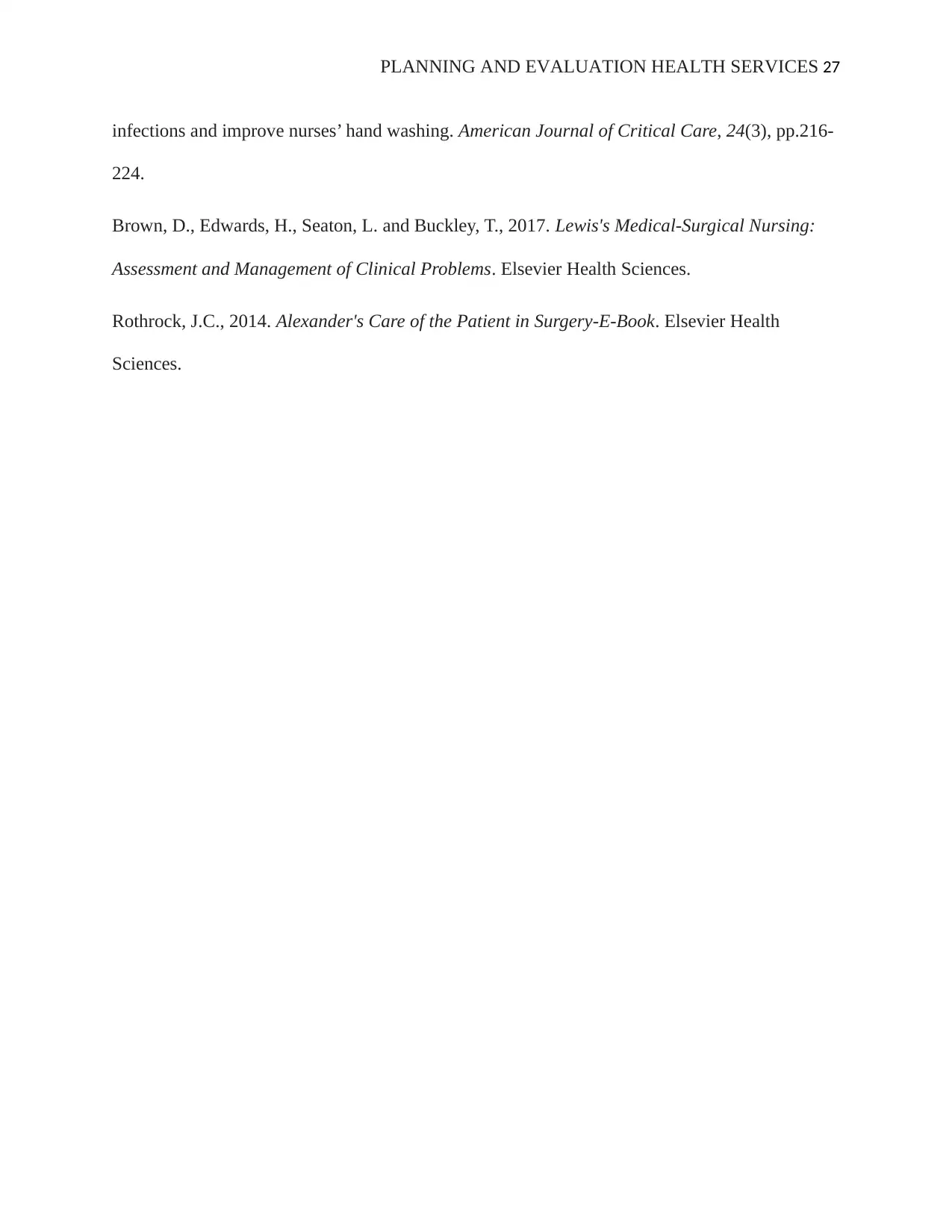
PLANNING AND EVALUATION HEALTH SERVICES 27
infections and improve nurses’ hand washing. American Journal of Critical Care, 24(3), pp.216-
224.
Brown, D., Edwards, H., Seaton, L. and Buckley, T., 2017. Lewis's Medical-Surgical Nursing:
Assessment and Management of Clinical Problems. Elsevier Health Sciences.
Rothrock, J.C., 2014. Alexander's Care of the Patient in Surgery-E-Book. Elsevier Health
Sciences.
infections and improve nurses’ hand washing. American Journal of Critical Care, 24(3), pp.216-
224.
Brown, D., Edwards, H., Seaton, L. and Buckley, T., 2017. Lewis's Medical-Surgical Nursing:
Assessment and Management of Clinical Problems. Elsevier Health Sciences.
Rothrock, J.C., 2014. Alexander's Care of the Patient in Surgery-E-Book. Elsevier Health
Sciences.
You're viewing a preview
Unlock full access by subscribing today!
1 out of 27
Related Documents
Your All-in-One AI-Powered Toolkit for Academic Success.
+13062052269
info@desklib.com
Available 24*7 on WhatsApp / Email
![[object Object]](/_next/static/media/star-bottom.7253800d.svg)
Unlock your academic potential
© 2024 | Zucol Services PVT LTD | All rights reserved.





